Further Revised- 1/26/20
Reviews Include:
–Finnex
Ray 2 DS/DB/BB
FugeRay Original, Planted +, Marine
Planted + 24/7
–Fluval
Fresh & Plant 2.0
Marine & Reef Performance LED
Eco Bright
Aquasky
Desktop (Nano) Series
Ultra Bright LED
Zetlight Qmaven- Maxspect & illumenAir
–TMC AquaBeam/AquaGro
2000 Reef White, 1500 Ocean Blue, 1500 GroBeam/Colour Plus Tiles
600 Ultima Strips, Mini 400 & 500
–
TMC Aqua Red & Blue Flexi-LED, Truelumen
TMC AquaBar LED
–Aqua Illumination
SOL, Sol Blue
Vega (AI Vega Color, Blue)
Hydra FiftyTwo & TwentySix [New updated HD models]
Prime
–Current Satellite
Satellite Freshwater + LED
Satellite Freshwater + Pro
Marineland Reef Capable & Double Bright
Blue Moon Aquatic & TaoTronics LED
Evergrow, Ocean Revive, & SB Reef Lights LED
Kessil Freshwater & Saltwater, including AP700
Other LED Aquarium Lights (such as the Boost LED, Orphek)
Forward:
As written in the forward in my other LED Lights Article. Likely, over time my biases will change, since LED lighting is a fast developing and changing aspect of aquarium keeping. Especially among those keeping reef and high tech planted aquariums.
From brand patents/exclusive license agreements, drivers, dimming, input/output energy, and more, the science speaks for itself!! The repeated experiences back up the science! Lighting and aquariums ARE science, albeit with art and personal preferences mixed in!
I try and mix simplified science for easy reading along with a lot of practical experience in this article. I cite many other related articles to back up the science and hopeful to make it easier for a overall easy learn of a very complex topic of aquatics. This information is backed up by experienced individuals, which I know well.
If we can understand the overall aquarium LED fixture, we can make an informed decision on our aquarium LED purchases.
Please read ALL my cited references and consider reading my other articles about Aquarium Lighting. They provides some foundation to the hows and whys of this article.
This includes consulting with professionals, which also includes consulting for lights I have not used as well as the use of pictures to fairly display all lights reviewed. These pictures show that pretty much all the lights reviewed will get the job done in some form or another.
I often make comparisons using one light in particular as a standard, but this does not mean the other lights do not work, far from it. But to not make provable comparisons using one light as a standard such as input wattage to output PUR would simply not make for an honest review. In the end, it is quite common in review to set up one product as a standard, such as using a Mercedes as a standard to compare other cars to. This does not mean a Mercedes is the car for everyone and that other cars do not work [of course this analogy may be poor in that I actually do not know what car might be the best one to set as a standard, but I am sure readers get the point!].
As well, this post/article is meant as a complement to this article:
LED Aquarium Lights, Lighting
This post is also meant as a compliment to a newer article:
Choosing Your Aquarium LED Lights
Overview:
Whenever choosing an LED, make sure it’s known as to what is trying to be achieved, such as Reef, Freshwater Planted, Nano Reef, Deep Freshwater Planted, etc.
Here’s how each of these reviews will be laid out:
* Review-
This Review will often include comparisons where they can be factually established as to input energy to PAR output for the simple reason that when LED aquarium lights first became a viable alternative for advanced planted and reef aquarims, the main reason to utilize LED was for their high efficiency compared to other lighting types.
Unfortunately of late, while most all popular aquarium LED lights can keep Reef or Planted tanks as advertised, many come at vastly lower efficiencies, some even rivalling Metal Halides in energy usage, which in this authors opinion defeats the purpose of utilizng LEDs in the first place.
* Specifications-
* Input/Output Energy
–Watts: where known for specific models used as examples
–PAR: where known for specific models used as examples
–Spectrum:
–Kelvin:
* Circuity/Dimming-
* Spread-
* Waterproof-
* Features-
* Mounting-
* Warranty-
* Resources-
* Coloration-
*FugeRay Original, Planted +, Marine
* Review, including overall review of ALL Finnex Lights-
This line of the Finnex is very similar to the Ray 2 models, but it does space out the emitters differently, which Finnex claims is idea for “refugium purposes as well as low-medium light needy aquariums”. This model does come with a moonlight switch. It also has a moisture resistant PC Splash Guard to protect against water mishaps.
The Planted 24/7 version offers “true” 660nm red LEDs, unlike others using just “red” LEDs.
Studies have found to be one of the most efficient wavelengths for plant photosynthesis. This also gives a warmer look to an aquarium.
Using the 20 inch model as an example; it has these emitters:
(72) 7000k, (40) 660nm RED, (8) Blue Moonlights
With this many emitters and a cost price point, these are clearly daisy chained together, which is OK for Christmas lights, but not high end LED fixtures. The result is loss of spectral quality (this is an undisputable fact too).
Reference: Aquarium Lighting Facts & Information; LED Lights
Again using the 20 inch model, at 15 watts input energy its output in “useful light energy” is poor compared to better built, non daisy chained LED lights such as the AquaRay.
With this 20″, 15 watt model Finnex, the PAR at 400mm of air tests at 40 µMol•m²•sec. This is .37 watt of input energy per mm of PAR.
Again compare to the 12 watt GroBeam #600 @ 61 µMol•m²•sec for the same distance with a much higher PUR as well. This is .19 watt of input energy per mm of PAR.
Similar comparisons could be made with other “high end” LEDs such as the BML, AI Hydra that do not daisy chain emitters and use better emitters to start with over the low cost, low output no name emitters used by Finnex.
Taking this comparison a step further, since the “raw” PAR data suggests 1/3 lower PAR for the same size 20″ inch Finnex compared to the 20″ 12 watt GroBeam #600, we also need to add in the loss of spectral quality via daisy chaining and low efficiency low cost emitters compared to the licensed CREE emitters, and this 1/3 lower output easily becomes 50% or more.
This means using a 24″ 20 gallon aquarium, you would need at least two 20″ 15 Watt Finnex lights to do the same job as one 20″ 12 watt AAP AquaRay GroBeam. So any up front savings really are not there for objective aquarium keepers
Based on the very poor warranty (180 days), lack of a good water resistance rating, and energy output efficiency, I can only recommend these lights for those seeking to save $20-$30 short term, this is assuming your planted aquarium could get by with less light from the Finnex and does not need two Finnex where one better LED would work).
Long term savings will quickly evaporate on these Finnex lights based on lifespan and energy usage for results achieved since it can easily be assumed from known PAR & PUR data that it it would take twice the input wattage of Finnex to equal the PAR/PUR output of the AAP/TMC AquaRay GroBeam.
Further Reading: PUR, PAS, PAR in Aquarium Reef/Planted Lighting
* Specifications-
* Spread-
120 degree
* Features-
Moonlight
* Mounting-
Rim Mount Included
* Power Usage-
9 to 36 watts depending upon size of fixture
* PAR-
40 µMol•m²•sec in air at 400mm for the 15 watt 20 inch models tested for this article
* Warranty-
180 Day, very limited
* Resources-
http://www.finnex.net/index.php/fugeray_series/?___store=default
*Planted + 24/7
* Review-
For the full review of all Finnex LED lights in general, based on gathered data, see the review under the Finnex FugeRay
The thing that sets this fixture apart from the rest of the Finnex line is the season cycle, along with coloration control. The fixture focuses on use visual and feature appeal. The features have good reviews. Growth is moderate. Since the fixture has these features, which require dimming, they must be using 0-10v dimming.
–Spectrum: [See Resource]
–Kelvin: 7,000K
* Circuity/Dimming-
0-10v Standard Dimming
* Features-
Fully Automated, hand free daylight and night cycle
Clouds, thunder, sun, and moon settings
4 different memory modes
4 Channels
Controller
* Mounting-
Rim Mount Included
* Power Usage-
15 to 36 watts depending upon size of fixture
* PAR-
40 µMol•m²•sec in air at 400mm for the 15 watt 20 inch models tested for this article
* Warranty-
180 day, very limited
* Resources-
http://www.finnex.net/index.php/plantedautomated/?___store=default
*Finnex Ray 2 DS/DB/BB
* Review-
For the full review of all Finnex LED lights in general, based on gathered data, see the review under the Finnex FugeRay
This version of the Finnex comes in three different versions. There’s a daylight 7,000K, 10,000K, and 460nm marine actinic blue. These fixtures pride them self on a quality aluminum design, which helps heat escape from the emitter, through the fixture and out. One fixture, they compare to (3) T5 lamps. With a water slash guard type of len over all emitters. The lens can be removed for easy cleaning. The emitters are ceramic and not plastic.
These fixtures are not designed to dim, without any option to do so. There are no features listed for the unit.
* Specifications-
Ray 2 DS
Model Dimensions LED #LEDs Type Wattage
RAY2 16DS 16″x3.75×1(h) 7000k 88 3014 9w
RAY2 18DS 18″x3.75×1(h) 7000k 96 3014 15w
RAY2 24DS 24″x3.75×1(h) 7000k 144 3014 20w
RAY2 30DS 30″x3.75×1(h) 7000k 144 3014 20w
RAY2 36DS 36″x3.75×1(h) 7000k 192 3014 29w
RAY2 48DS 48″x3.75×1(h) 7000k 288 3014 39w
Ray 2 DB
Model Dimensions LED #LEDs Type Wattage
RAY2 16DB 16″x3.75×1(h) 10000k / Actinic 88 3014 9w
RAY2 18DB 18″x3.75×1(h) 10000k / Actinic 96 3014 15w
RAY2 24DB 24″x3.75×1(h) 10000k / Actinic 144 3014 20w
RAY2 30DB 30″x3.75×1(h) 10000k / Actinic 144 3014 20w
RAY2 36DB 36″x3.75×1(h) 10000k / Actinic 192 3014 29w
RAY2 48DB 48″x3.75×1(h) 10000k / Actinic 288 3014 39w
Ray 2 DB
Model Dimensions LED #LEDs Type Wattage
RAY2 24BB 24″x3.75×1(h) Actinic 144 3014 20w
RAY2 30BB 30″x3.75×1(h) Actinic 144 3014 20w
RAY2 36BB 36″x3.75×1(h) Actinic 192 3014 29w
RAY2 48BB 48″x3.75×1(h) Actinic 288 3014 39w
* Features-
N/A
* Mounting-
Rim Mount included
* Warranty-
180 day, very limited.
* Resources-
http://www.finnex.net/index.php/ray2_series/?___store=default
*Fluval Fresh, Marine, Eco Bright, Aquasky, Desktop, Ultra Bright
* Review, including overall review of ALL Fluval Lights
The Fluval LEDs is a economy build that has evolved into a very nicely aesthetically designed line of LED aquarium lights.
Fluval also claims German engineered (but then so are Tetra brand fish foods)
Fluval has added IP67 waterproofing, which few LEDs other than AquaRay have had. As well the warranty at 3 years is one of the better warranties, with only the AquaRay line beating this with 5 years.
However, the Fluval still use multiple no-name low cost emitters that are daisy chained together, instead of fewer HO quality emitters run with appropriate drivers/circuitry such as the AI, AquaRay, and other premium LEDs.
It is well known that it is not cost efficient to drive high numbers of emitters with proper voltage, so daisy chaining is used for LEDs such as the fluval, Satellite, & Finnex. This results in lower spectral quality (PUR) and lower efficiency which shows in the low PAR and PUR output per input wattage. As well dimming is analog, which also lowers spectral quality.
Reference: Aquarium Lighting Facts & Information; LED Lights
An example would be the Fluval Fresh & Plant 2.0 A3990 which uses 32 watts of input energy with a PAR output about 70 µMol•m²•sec at 400mm. This is .45 watt of input energy per mm of PAR.
However the 30 Watt AquaRay GroBeam 1500 produces a PAR of about 150 µMol•m²•sec at 400mm using 30 watts input energy. This is .20 watt of input energy per mm of PAR!!
This does not even take into consideration the higher sprectral quality of tuned specific licensed Cree emitters controlled by PWM versus analog dimming.
Another way to think about it. The 32 watt Planted Fluval 2.0 rates about 70 µMol•m²•sec at 400mm for $135, where the AquaRay GroBeam 12 watt rates about 61 µMol•m²•sec at 400mm for $123. So, watt per dollar, you get a better value with the AquaRay, with less watts about the same PAR, all with the other perks of a patented solid build and a 5 year warranty. This doesn’t even take in account PUR and the amount of emitters used in each fixture, which if is taken into account, the AquaRay GroBeam would have more useful energy and cost less, with a more secure build.
Fluval also claims “high CRI” however we already know that this is not a parameter to consider for aquarium lighting and is a marketing strategy often employed by lights with less than adequate PUR since CRI is easy to achieve.
Reference: Aquarium Lighting Facts & Information; CRI
So it is easy to see that while a nice sleek fixture, the Fluval is still at heart a basic economy LED masquerading as a quality HO LED!
Fresh & Plant 2.0
* Input/Output Energy-
–Watts: 32w-59w
–PAR: [See Specifications]
–Spectrum: Full Spectrum

–Kelvin: 7500K
* Circuity/Dimming-
0-10v Standard Analog Dimming
* Spread-
120 Degree
* Waterproof-
Waterproof IP67
* Features-
German-engineered
ultra-slim 1” profile
dimmable .touch switch
Can be mounted lower for less light loss
All lights on or only blue lights
* Mounting-
On frame
With a cabinet
Supension
Extendable
* Warranty-
3 Year Parts and Repair
* Resources-
Fluval Fresh & Plant 2.0
* Coloration-
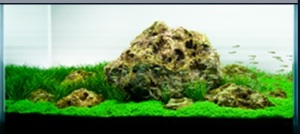
————————————————————————————————————————————————————————-
Marine & Reef Performance LED
* Specifications-
[See Resource]
* Input/Output Energy-
–Watts: 25w-46w
–PAR: Not Specified
–Spectrum: Full Spectrum
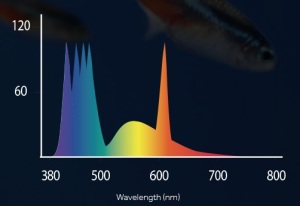
–Kelvin:25000K
* Analog Circuity/Dimming-
Day & Night Mode
* Spread-
120 Degree
* Waterproof-
N/A
* Features-
6 unique LED Band Waves for maximum growth and colour
* Mounting-
With a cabinet
Supension
On frame
Extendable
* Warranty-
N/A
* Resources-
Fluval Marine & Reef
* Coloration-

—————————————————————————————————————————-
Eco Bright
* Specifications-
[See Resource]
* Input/Output Energy-
–Watts: 7w-18w
–PAR: Not Specified
–Spectrum: Not Specified
–Kelvin: 7500K
* Analog Circuity/Dimming-
0-10V Dimmer in 25% increments
* Spread-
120 Degree
* Waterproof-
N/A
* Features-
German Engineered
Natural Shimmering Effect
energy-efficient LED system
intelligent infrared remote control with presets
customize blue and white LED intensity
ultra-slim 1” platform
Daytime and Nighttime
* Mounting-
Extendable
* Warranty-
1 Year Parts and Repair
* Resources-
Fluval Eco Bright
* Coloration-
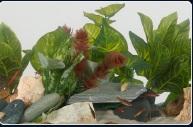
————————————————————————————————————————————————
Aquasky
* Specifications-
[See Resource]
* Input/Output Energy-
–Watts: 18w-35w
–PAR: N/A
–Spectrum: N/A
–Kelvin: 3000-25000K
* Analog Circuity/Dimming-
0-10V Dimming
* Spread-
120 Degree
* Waterproof-
Waterproof IP67
* Features-
German Engineered
endless color blends & multiple sky effects
Daytime & Nighttime
SKYpad infrared remote
Super bright 6500K white LEDs with tri-colored RGB (Red, Green, Blue) LEDs
Mount lower for no light loss
Ultra Slim Design
* Mounting-
extendable
* Warranty-
3 Year Parts and Repair
* Resources-
Fluval Aquasky
——————————————————————————————————————————————————————-
Desktop (Nano) Series- Aura, Halo, Nano
* Input/Output Energy-
–Watts: 12w-22w
–PAR: 32-762
–Spectrum:

–Kelvin:7500-25000K
* Circuity/Dimming-
0-10V Dimming- Halo and Aura models only
White/blue Control
* Spread-
120 Degree
* Waterproof-
Waterproof IP67
* Features-
German Engineered
C.O.B. (chip-on-board) technology
Mount lower for less light lose
* Mounting-
Adjustable Positioning Arm
* Warranty-
3 Year Parts and Repair
* Resources-
Fluval Desktop Series
* Coloration-
[See Spectrum}
——————————————————————————————————————————————–
Ultra Bright LED
* Specifications-
[See Resource]
* Input/Output Energy-
–Watts: 9w-32w
–PAR: N/A
–Spectrum: Full Spectrum

–Kelvin:7000K
* Circuity/Dimming-
N/A
* Spread-
120 Degree
* Waterproof-
N/A
* Features-
A shimmering effect is created
Can be used with deeper tanks
Solid aluminum housing
Compact and lightweight
Daytime and Nighttime
* Mounting-
extendable
* Warranty-
N/A
* Resources-
Fluval Ultra Bright
* Coloration-
N/A
*Zetlight Qmaven/Maxspect R420R/TMC V2 iLumenAir
* Review- Maxspect, iLumenAir, Zetlight
Maxspect Razor, TMC V2 iLumenAir, are all based on the same general basic build as the Zetlight Qmaven.
Made in Honk Kong. Zetlight reserves some of its technology ONLY for their name brand line and iLumenAir such as the smart fan and better emitters.
Zetlight also has other LED models, not reviewed in this article at this time. (Mini Aquarium Series, Nano Aquarium Series, Aqua Aquarium Series, Pro Aquarium Series, Project Aquarium Series, IOZEAN Aquarium Series, Lancia Aquarium Series, and Shieldo Aquarium Series).
The use of cooling fans implies that the Zetlight Qmaven, Maxspect R420R, & TMC V2 iLumenAir all use 0-10V “Current Reduction” versus the superior PWM to control the emitters.
See: Aquarium LED Lighting- PWM
The negatives again are the LACK of energy conserving, light efficient PWM controller technology, less than desirable PUR due to the many colored LEDs, and less than optimum PUR efficient emitters.
Part of the problem is the use of warm white and cool white emitters, such as the Cree XPG 3000k warm white, which is not an emitter best used for aquatic applications.
The Maxspect has the least amount of features compaired to the others.
This said, these are nice LED fixtures for those desiring a good light for coloration of their reef specimens where an efficient lower wattage per PUR/PAS fixture is not important. These are clearly not the best as per the known science of aquarium lighting, but are certainly reef capable at albeit a higher cost of operation (and higher carbon footprint), as well as shorter useful product lifespan.
Zetlight Qmaven ZT6500
* Specifications-
Emitter Type: Bridgelux & Cree
2 x Daylight: (12000K) 35 Watt super daylight chips
20 x Royal Blue 3w (450-465nm)
4 x Blue LED 3w (465-485nm) (Cree XT-E)
6 x Violet LED 3w (410-420nm)
3 x Green LED 3w (520-535nm)
3 x Red LED 3w (620-630nm)
2 x Orange/Amber 3w LED (610-620nm)
* Input/Output Energy
90 Watt, 1 fan
PSU Input: 100-240V
PSU Output: N/A
–PAR: 200-300 @ 8 inch of water [See Spread]
–Spectrum: [See Resource]
–Kelvin: [See Resource]
* Circuity/Dimming-
Dimming capable. 0-10 V
No more info on Circuity
* Spread- [See Resource]
* Waterproof- N/A
* Features-
Designed to be primarily cooled passively, the body is entirely in aluminum, serving as a large heat sink. With the aerodynamic design, cool air is brought through the bottom of the fixture and heat will be dissipated through the aluminum chassis. With a built-in temperature controlled system, with active cooling.
Simulate dawn, sunrise, sunset & nighttime
Toughen transparent len cover. Holds back humidity
Water Resistant Connector Plug
Digital Screen Display
Infra Red Controller
* Mounting-
Slide out mount, with lock
* Warranty- 1 year
* Resources-
http://zetlight.com/index.php/products?id=74
—
Maxspect R420R
* Specifications-
Emitter Type: Cree & Epliles
M10000 (10,000K)
12 x Cree XT-E Cool White 8000 Daylight emitters
6 x Cree XT-E Warm White 3000 Daylight emitters
9 x Cree XP-E Blue (465-485nm)
6 x Cree XT-E Royal Blue (450-465nm)
6 x Eplileds Dual Core Violet (410-420nm)
M16000 (16,000K)
6 x Cree XT-E Cool White 8000 Daylight emitters
12 x Cree XT-E Royal Blue (450-465nm)
6 x Cree XT-E Warm White 3000 Daylight emitters
9 x Cree XP-E Blue (465-485nm)
6 x Eplileds Dual Core Violet (410-420nm)
A8000 (8000K)
6 x Cree XT-E Cool White 8000 Daylight emitters
4 x Cree XT-E Warm White 3000 Daylight emitters
3 x Cree XP-E Blue (465-485nm)
* Input/Output Energy
Meanwell NES-75-15 (60w)
Meanwell NES-150-24 (120w)
Meanwell NES-200-36 (160w) (actual output 117 watt)
PSU Input:
1.5A/115VAC – 0.9A/230VAC (60w)
4.5A/115VAC – 2.5A/230VAC (160w/120w)
PSU Output:
15V 5A (60w)
24V 6.3A (120w)
36V 5.9A (160w)
–PAR: 100-300, 24 inch water [See Spread]
–Spectrum: [See Resource]
–Kelvin: N/A
* Circuity/Dimming-
Dimming capable. 0-10 V
No more info on Circuity
* Spread- [See Resource]
* Waterproof- N/A
* Features-
Smart Fan
Simulate dawn, sunrise, sunset & nighttime
* Mounting- Slide out mount
* Warranty- 1 Year
* Resources-
http://www.maxspectusa.com/index.php?option=com_content&view=article&id=20&Itemid=21
* Coloration-
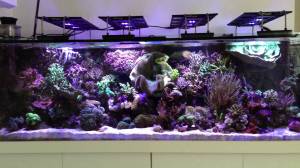
264g reef tank with 4 LED Maxspect Razor R420R 120W 16,000K
—
TMC V2 iLumenAir
* Specifications-
Emitter Type: Bridgelux
V2 iLumen Air 600
1 x 35W (6500K) diode
12 x 3W Royal Blue (465nm)
8 x 3W Red (620-630NM)
V2 iLumen Air 900
2 x 35W (6500K) diodes
24 x 3W Royal Blue (465nm)
3 x 3W Red (640nm)
3 x 3W Green (530nm)
2 x 3W Amber(605nm)
V2 iLumen Air 1200
2 x 45w (12000k) diodes
30 x 3w Royal Blue (465nm)
6x 2w Red (640nm)
6 x 3w Green (530nm)
2 x 3w Amber (605 mn)
* Input/Output Energy
Air 600- 80 Watt, 1 fan
Air 900- 170 Watt, 2 fan
Air 1200- 215 Watt, 2 fan
PSU Input: N/A
PSU Output: N/A
–PAR: 100-400, 17 inch water [See Spread]
–Spectrum: [See Resource]
–Kelvin: N/A
* Circuity/Dimming-
Dimming capable. 0-10 V
No more info on Circuity
* Spread- [See Resource]
* Waterproof- N/A
* Features-
Designed to be primarily cooled passively, the body is entirely in aluminum, serving as a large heat sink. With the aerodynamic design, cool air is brought through the bottom of the fixture and heat will be dissipated through the aluminum chassis. With a built-in temperature controlled system, with active cooling.
Waterproof cable connections
Infra Red Controller
90 degree lens optics
Simulate dawn, sunrise, sunset & nighttime
Thermal cut out to protect the LED’s should overheating occur
Controllable blue LED trim to enhance
Power read out indicates electricity use
* Mounting-
Adjustable tank mounted (fittings included) or suspended (kit sold separately)
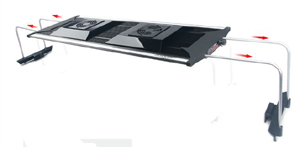
* Warranty- 1 Year
* Resources (To purchase)-
V2 iLumenAir (ZetLight)
* Coloration-

BC Aquaria Maxspect
*Maxspect Mazarra
* Review-
The use of cooling fans implies that the Maxspect Mazarra use 0-10V “Current Reduction” versus the superior PWM to control the emitters.
See: Aquarium LED Lighting- PWM
The Maxspect Mazarra lighting system is one the first LED systems on the market to utilize the 410/420nm Super Actinic LED chips (violet). Maxspect claims this spectrum is crucial for the success of any reef and water plant aquariums as it is required by Chlorophyll A for photosynthesis, where absorption peaks at 412nm.
While this claim is not fully substantiated, there is evidence that SOME corals need this spectrum for proper growth. However, little evidence exists that this spectrum is needed for freshwater aquarium plant growth.
Other fixtures do have this color of emitter as well.
* Specifications-
Emitter Type: Cree, Philips, Epileds
Mazarra- P Series
4 x Cree XM-L Cool White 7000-8000
4 x Philips Luxeon Rebel 460-490 Blue
4 x Philips Luxeon Rebel 440-460 Royal Blue
1 x Epileds Dual-Core 400-410 Super Actinic
1 x Epileds Dual-Core 410-420 Super Actinic
2 x Cree XP-G 3000K Warm White
(XM-L Cool White bin is actually 5500K!! Based on Crees own data)
Mazarra- X Series
4 x Cree XB-D Cool White 7500
2 x Epileds Dual-Core 410-420 Super Actinic
2 x Cree XB-D Warm White 4000
4 x Cree XP-E 465-485 Blue
4 x Cree XP-E 450-465 Blue
* Input/Output Energy
P Series:
PSU Input- 4.5A/115VAC – 2.5A/230VAC
PSU Output- 14A
X Series:
PSU Input- 4.5A/115VAC – 2.5A/230VAC
PSU Output- 36V 5.9A
Watts: 110w
–PAR:
P Series: [See Resource per lens]
X Series: [See Resource per lens]
–Spectrum:
 The spectrogram is missing some important points of PUR and full spectrum PAR. Not to say this is not a good spectrogram, only that it could be better.
The spectrogram is missing some important points of PUR and full spectrum PAR. Not to say this is not a good spectrogram, only that it could be better.
[See Resource]
See: PUR vs PAR in Aquarium Lighting- Including Spectrographs
OR: “Useful Light Energy- PUR”
–Kelvin:
P-Series: N/A
X-Series: N/A
* Circuity/Dimming-
Dimming capable. 0-10 V
No more info on Circuity
* Spread- [See Resources]
* Waterproof- N/A
* Features-
The Mazarra-X Lighting system can be connected to PC through USB, allowing users to update firmware easily through the USB connection. Upcoming Maxspect Computer Control program will also allow users to program photo-period profile directly from the PC and upload the profile onto the master module.
Wireless Controller
Modularized Units
Weather Mode. Dawn/Dusk Mode
Master/slave mode, which can control up to 16 units
6 Photo-Period Time Point
Aerodynamic design
Versatile Mounting System
Selection of 40°, 70° and 100° optics
* Mounting-

Nice adjustable mount design
* Warranty- 1 Year
* Resources-
Maxspect Mazarra P-Series
Maxspect Mazarra X-Series
* Coloration-
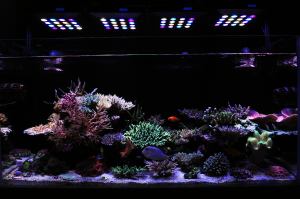
Maxspect Mazarra par Aquarioom
*AAP AquaRay AquaBeam/AquaGro- 2000 Reef White, 1500 Ocean Blue, 1500 GroBeam & Colour Plus Tiles
Review:
The AAP/TMC AquaRay is one of the leaders in both Reef and Planted freshwater aquarium LED lighting [especially in Europe], with 11 different module fixtures to mix and match depending on species being kept and aquarium specification. Their PAR/PUR efficiency and warranty is unrivaled which is why in part, I use the AquaRay as the standard to measure all other aquarium LED lights by, despite the mass marketing of many others that has allowed many others to become more household names.
Emitters are fully licensed or patented, meaning no other fixtures have these emitters.
They also have an exceptional 5 year warranty to back them up, which is far longer than most all other aquarium LEDs.
Another aspect I like about the TMC AquaRay line of LED lights is their patented mounting system that is like not other LED with vastly more mounting options than any other aquarium LED light, advanced or economy.
Based on the known science of aquarium lighting, what sets their LED Light fixtures apart are these factors:
- The licensed Cree and patented innovative Osram Oslon emitters, which no other fixtures have for the highest PUR output at the lowest watts.
Instead of warm white or cool white emitters, the AAP AquaBeam/AquaGro LEDs use more reef or planted freshwater friendly kelvin temperature emitters.
These emitters are also aquarium specific meaning they are meant to be used in a more wet environment and can handle larger voltage swings, due to long term exposure to moisture. In fact, the AquaRay LEDs have a water resistant design of IP67. This is the highest level of protection, no other Aquarium LED has this rating.
- TMC uses precise drivers/circuitry to power each emitter, so as to maintain spectral quality. Unlike other LEDs, which daisy chain their emitters together. Almost like chaining Christmas lights together. Other good/excellent “High End” LEDs such as Aqua Illuminations, EcoTech, V2 iLumenAir/Maxspect, and Kessil do not daisy chain their emitters either.
- The AquaRay line of LEDs ARE THE MOST EFFICIENT aquarium LED as per input energy to PAR using 400m as a measurement. This is worthy of note that even leaving out the longevity, warranty, and highest PUR, the simple measurement of PAR shows that where two or more of one fixture might be needed, only one Aquaray might be needed.
The watt per micro-mol of PAR ranges from .08 watt to .20 watt per mm of PAR for Aquaray LED fixtures.
Other LEDs such as the Beamworks are as high as 2.7 watts per mm of PAR!
The ONLY Professional Full Service Online Product Resource in North America:
AquaRay Lighting
Beware of posers selling this product with names that imply official and experience, as neither is true.
The above link is the ONLY North American online seller with a decade of experience selling this product and decades of professional lighting experience behind it.
In fact in investigating further, I found that a certain parasite garage retailer now has two deceptive web sites shadowing each other selling the Aquaray and unfortunately Google Search rewards this “black hat” SEO with top billing!
Do not make the mistake of purchasing from a garage seller!
—
* Specifications-
Emitter Type: Cree & Osram Oslon
30 watt AquaBeam Reef White 2000
4 x 10,000K extremely high output NEW patented Cree XT-E -Focused Lens
2 x “Fiji Blue” Cree XT-E (deep blue) -Focused Lens
4 x NP (Nature Perfect) Osram Oslon full spectrum Blue -Focused Lens. (18,000k) with a correlated color temperature of 20,000K.
30 watt AquaBeam Ocean Blue 1500
4 x 10,000K extremely high output NEW patented Cree XT-E
2 x “Fiji Blue” Cree XT-E (deep blue)
4 x NP (Nature Perfect) Osram Oslon full spectrum Blue. (18,000k) with a correlated color temperature of 20,000K.
30 watt AquaBeam Coral Colour Plus 1500
2 x 10,000K extremely high output NEW patented Cree XT-E
2 x “Fiji Blue” Cree XT-E (deep blue)
2 x NP (Nature Perfect) Osram Oslon full spectrum Blue. (18,000k) with a correlated color temperature of 20,000K.
2 x Semi NUV emitters
1 x Cree Red Emitter

ABOVE: Reef Aquarium with New Coral Colour Plus added to Maxspect, within two weeks, Montipora & other sps growth was noticeably improved
30 watt AquaGro GroBeam 1500
10 x Cree XB-D 6500K

ABOVE: Aquascape with AquaGro Grobeam 1500 Daylight
30 watt AquaGro Colour (Color) Plus
4 x Cree XP-G 6500K daylight white
2 x Cree XP-E green
2 x Cree XP-E red
2 x Cree XP-E blue
* Input/Output Energy [See Resource]
–PAR:
–Spectrum:
–Kelvin:
* Circuity/Dimming-
Pulse with Modulation, separate controller
* Spread- [See Resource]
* Waterproof- IP67 Proof
* Features-
-Controller for Features (separate)
Multi channel
Ramp/dim, Sunrise, Sunset, moonlight
Wifi Compatible/PC Control Panel
Storm/30 day lunar cycle
Temperature probe
Slave Mode
* Mounting-
In-hood (provided), Modular, Suspended
* Warranty- 5 Year Registered
* Further Resources/Information-
Reef White 2000
AAP Reef White 2000 Specifications
Ocean Blue/Coral Colour Plus 1500
AAP Ocean Blue 1500 Specifications
GroBeam 1500/Color Plus
AAP GroBeam 1500 Color Plus Specifications
Purchase Aquarium LED Lighting; What to Know
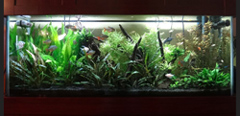
A 75 gallon planted with two GroBeam earlier generation LED tiles is pictured to the left.
Below is snip of a large reef aquarium utilizing AquaBeam Reef White 2000s & Ocean Blue 1500s.
AAP/TMC AquaBeam/AquaGro- 600 Ultima Strips, Mini 400 & 500:
* Specifications-
Emitter Type: Cree
12 watt Marine White 600
14,000K
6 x 9K Cree ML-E Daylight
2 x Cree ML-E Reef Blue

12 watt Reef White 600
18,000K
4 x 9K Cree ML-E Daylight
4 x Cree ML-E Reef Blue

12 watt Marine Blue 600
20,000K
2 x 9K Cree ML-E Daylight
6 x ML-E Reef Blue

12 watt Reef Blue 600
465nm
8 x Cree ML-E Reef Blue
12 watt Fiji Blue 600
450nm
5 x Cree XT-E Blue
12 watt GroBeam 600
5 x 6500K Daylight XB-D
 12 watt MiniLED 500
12 watt MiniLED 500
4 x Cree licensed XP-E 10,000K- focused lensed
1 x Cree XP-E 465nm Blue
NOTE: designed for small Nano Reef Tanks under 15 gallons, although multiples work quite well for larger aquariums where the “square” light spread might be desirable over multiple strips (the picture displays this light with a “MountaRay” bracket for easy attachment to small tanks).
4 x Osram Oslon SSL High Power 6500K
The Mini 400 uses four new high output OSRAM OSLON SSL High Power 6500K LED Emitters.
12 watt AquaBeam NUV
5 x Cree Near Ultra violet

* Input/Output Energy [See Resource]
–PAR:
–Spectrum:
–Kelvin:
* Circuity/Dimming-
Pulse with Modulation (PWM), separate controller
* Spread- [See Resource]
* Waterproof- IP67 Proof
* Features-
-Controller for Features (separate)
Multi channel
Ramp/dim, Sunrise, Sunset, moonlight
Wifi Compatible/PC Control Panel
Storm/30 day lunar cycle
Temperature probe
Salve Mode
* Mounting-
In-hood (provided), Modular, Suspended
* Warranty- 5 Year Registered
* Resources-
TMC Marine Reef White Blue Specifications
FURTHER REVIEW:
- The AquaRay LEDs apply latest technology to controllers, which dim and brighten an LED fixture. As a controller best maintains the spectral output via pulse width modulation (PWM).
The importance of PWM is this technology is effectively turning the LEDs on and off very quickly (faster than the eye can see) so there’s no change to the spectral output as opposed to using 0-10v dimmer used by many brands of LED fixtures and LED Controllers.This is what really sets the TMC AquaRay apart from others, since there’s little heat loss with PWM compared to other methods. This is also for long-term security of the emitters, as over time with a moist environment, spectrums and emitters can start to degrade.
The AAP AquaRays do not have fans, which is a large plus considering the life of the fan will never last as long as the emitters are rated for.
With less heat, these means more energy is being used as light and less watts of energy are being used. This also helps makes the fixture completely IP67 waterproof.Probably the only downside to this technology is the complexity of the circuitry and it does come with a price. A separate controller is needed. AquaRay chooses to keep their dimmer separate, as not everyone needs it and the fixtures can simply be raised and lowered or a good grounded timer can also be used [which is what most persons used until LEDs became practical].
A higher pitch sound also has been reported with PWM dimming, but is something not noticeable unless someone is specifically listening for it and can’t hear it over other sounds of the aquarium. It is also worthy of note that other Aquarium LEDs use fans, which make their own noise and often breakdown prematurely, so this is a draw here.
Other complaints are that the TMC controllers are not as user friendly, although their new Smart Controller 8 with new features certainly voids this issue, at least in part. Now the new controller has more user features not even found with other common fixtures. Either way the use of PWM and lower heat loss resulting in more light overrides these issues in my experience/opinion as well as with interviews with aquarium keeping professionals.
See Reference: Aquarium LED Lighting- PWM
The result of these industry leading technologies as well as not going with the gimmicky, yet popular multiple color emitters such as green/yellow/orange emitters [with the exception of the Colour Plus], these TMC AquaBeam & AquaGro GroBeam have the highest PUR output for the lowest wattage input, often by a very wide margin.
Further Specific TMC AquaBeam/GroBeam Information
 The excellent TMC 1000 Ultra has been replaced as of August of 2013 with the AquaBeam 2000 NP Ultima.
The excellent TMC 1000 Ultra has been replaced as of August of 2013 with the AquaBeam 2000 NP Ultima.
Pictured below is a Reef White 2000 NP Ultima and 600 Ultima NUV LEDs over a 60 Gallon Reef Aquarium
See this separate review of the 1500 & 2000 Ultimas:
*TMC AquaBeam Ocean Blue 1500 NP Review
*TMC AquaBeam Reef White 2000 NP Review
The new 1500 & 2000 LED combines the exclusive and licensed Cree 10000K XT-E daylight emitters with the high output XT-E Fiji Blue.
Even more impressive is the TMC Ocean Blue NP 1500 & Reef White NP 2000 includes the patented innovative NP Blue Osram Oslon emitter which is specifically designed for photosynthetic reef life, providing a blue light, which still is full spectrum.
It provides the growing power of 20K, while having a 16K appearance. This is a higher level tech emitter, not available in any other aquarium fixture.
The picture below shows the spectrum of the Osram Olson ‘Natural Blue’ or ‘Nature Prefect’ (NP) emitter:

As well these TMC fixtures, continue to use advanced driver technology, which does not waste nearly as much heat energy as other comparable LED fixtures. Instead, much more energy goes to actually lighting your aquarium.
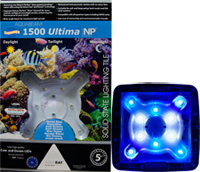 The TMC Ocean Blue NP 1500 is an excellent choice for aquarium keepers with tanks under 22 inches of depth desiring a very high output blue and daylight light combinations from a small footprint yet high output (high PUR) aquarium LED.
The TMC Ocean Blue NP 1500 is an excellent choice for aquarium keepers with tanks under 22 inches of depth desiring a very high output blue and daylight light combinations from a small footprint yet high output (high PUR) aquarium LED.
Here are some important points as to what the NP 1500 series LED lights can and cannot do:
- This is not a depth penetrating LED fixture despite its plethora of excellent blue emitters, this is due to the fact it is not focused unlike the TMC Reef White NP 2000. However these two fixtures can be combined 1 to 1 for tanks with 24-32 inches of water depth.
- NP 1500 has a much larger area of light output from the same small foot print of the 2000 tiles.
The NP 1500 with a beam angle of 120 degrees has a 24 x 24 inch light spread, with fixture at optimum 8-12 inches above tank. While the light spread is about 18 x 18 for the 2000 Ultimas, which have a 60 degree beam angle.
It is also noteworthy, the combined emitters used in the NP 1500 have a higher PUR in proportion to the testable PAR (PUR is the actual useful light energy).
Below is a video with a reef aquarium using AquaRay Ocean Blue NP 1500 LEDs

Reef Aquarium with Ultima NP LEDs Video
—
The 2000 tiles are still the most focused best depth penetrating (albeit with the lowest light spread) of all TMC AquaRay lights and quite bluntly MOST any other aquarium LED but for the Orphek & Kessil!
This makes the AquaBeam 2000 LEDs the best choice (as per TMC products) for tanks over 20-24″ in depth including deeper hexagon or similar reef aquariums.
As noted earlier with the 1500 NP Ocean Blue, this LED uses the exact same emitters, but with lenses producing a much smaller 60 degree cone of light with much more depth penetration.
The TMC 600 models are excellent as stand alone LED fixtures or as compliments to the 2000 and even 1500 models so as to add light spread in larger deep tanks.
See this review of the 600 Ultima:
*New TMC AquaBeam 600 Ultima Aquarium LED Light

TMC also now utilizes the newest licensed XT-E Deep Blue 450nm un-lensed emitters in their AquaBeam Fiji Blue Fixture (pictured above), which is an excellent compliment to the Marine White or even the AquaBeam Reef Blue for a very nice full blue spectrum, specifically for enhancing the fluorecence of corals. Notwithstanding, the EcoTech Radion does a nice job here too mixing blues.
While I personally have found this an excellent new offering from TMC the moonlight mode somewhat a gimmick based on known facts about moon light and its affect on corals, etc. However, TMC is simply bowing to customer demands here.
Please Reference: Aquarium Moon Lights Review
Also see this review of the 400 from Aquarist Magazine:
TMC Aquaray Mini LED 400 Aquarium Light Tile Review
Also see LED Aquarium Lights & Lighting for further LED information and as well for further information about the TMC AquaBeam 600 and 1000 Ultras.
—
Update 6-21-12
TMC had a failure of their quality control for the Ocean White 1500 in that CRee sent cool white emitters (those used by EcoExotic at the time) instead of the patented 9000-10000k XP-G emitters. These were installed in a few runs in the spring of 2012.
The fixtures in question have these numbers on the box side:
11-10-43-04
12-04-17-03
It is noteworthy, this mistake was caught by a couple of customers with a good knowledge of what a quality LED should produce in light energy and they noticed the difference from other TMC LEDs since these non licensed Cree cool white binned emitters used by most other LED manufacturers produce a more yellow, lower quality PUR light..
Here is an excellent newer website documenting the LED research at Saint Mary’s College of Maryland by Dr. Walter Hatch, THIS IS A MUST READ!

St Mary’s Marine Biology Experiments
*TMC Aqua Red/Blue Flexi-LED & Truelumen (by Current):
* Review-
These products are primarily decorative and are mostly useless for lighting an aquarium as per the necessary light energy, especially needed by freshwater plants or symbiotic zooanthellic algae found in many corals, clams, & nudibranchs.
That said, TMC is not marketing this product for anything other than minor supplemental or decorative lighting.
As an example, the Flexi-Red only provides subtle highlights of red (which might be great for some freshwater tetras, discus, etc.), however at night by itself this Flexi Red LED does add an interesting effect in the aquarium.
The Flexi-Red Strips are excellent for use with nocturnal fish such as Blennies, as many nocturnal fish are active with low level red lighting present in their aquarium. As well as a supplemental light, the Flexi-Red can be added to planted aquariums to add a small amount of additional near-infrared red light energy for plants such as Rotala.
The blue strips are excellent for use as a moon light for those who prefer a blue color for night lighting, notwithstanding that moon light is not actually blue, but this is the color most persons seem to prefer regardless.
Reference: Aquarium Moon Lights Review- Is Moonlite truly Blue
The TrueLumen by Current USA is similar, however it is unfortunately marketed by many as a main light source, while as with the TMC Flexi-Red the TrueLumen is only for supplementation.
The Kelvin Color temperatures (other than the Rose, Rose/White) are primarily for marine aquarium supplementation.
Both these products are nice ideas when properly used with the TMC available in 18 inch strips and the TrueLumen available in 10 inch strips.
Both are very easy to install with the TrueLumen available in more varieties while the TMC is a better value (due to a considerably longer strips for only a marginal amount of $ more).
* Input/Output Energy
PSU Input:100-240V 50/60HZ
PSU Output: 12 C DC 0.8 max
3 Watts
* Circuity/Dimming-
Dimming capable. 0-10 V
* Waterproof- N/A
* Mounting-
Stick on back
* Warranty- 2 Year
* Resources-
TMC Flex Red/Blue Adhesive LED Aquarium Lighting
*TMC AquaBar LED:
* Review-
This is a new offering by TMC that is made to TMC specification in China with 6500k White Samsung LED emitters instead of the patented Cree & Osram Olson Emitters supplied with their premium AquaBeam and GroBeam line of LED Lights.
Update: The AquaBar has been taken off the aquarium LED market.
*Aqua Illumination SOL:
* Review-
The Aqua Illumination SOL Aquarium LEDs use good quality, albeit older generation Cree XP-G 6500K and blue/royal blue XP-E series LEDs (AI does NOT have the license “rights” to the latest CRee emitters). The lenses and over all design is top notch.
The driver/circuitry is well designed as there is less heat generating heat spikes than some other LEDs using Current Reduction.
These LED fixtures are marketed more on features, rather the important: Useful Light Energy (PUR), NOT PAR only as some reviews may claim.
Please reference: Aquarium Lighting- Useful Light Energy, PUR.
This said, the AI Sol LEDs have interesting and admittedly cool features include proprietary 40 and 70 degree lenses and feature rich controllers that do an excellent job of getting light where it is needed.
The Aqua Illuminations LEDs are capable LED lights for many light reef applications with many reporting reasonable results.
This LED is essentially an older version 6500K planted freshwater light with good saltwater depth penetration of maybe 12″, combined with an excellent, but older binned (non patented) version XP-E blue CRee emitters, which are good for aquarium applications under 20 inches. Not for deeper tanks as many unaware reef keeper have used these LED fixtures for.
While the Aqua Illumination SOL is a good and capable LED light for many reef aquariums, at the price charged for this LED light fixture, there’s little reason to pay more, use more electricity, and get less.
Known facts about the emitters used in the AI Sol, this is still a good choice for reef tanks under 20 inches of depth.
This fixture has been discounted by the manufacture.
* Specifications-
Here is a break down of the popular AI Sol Super Blue:
Daylight:
Quantity: 8
Cree: XPG, 6500K
Blue:
Quantity: 8
Cree: XPE, 470nm
Royal Blue:
Quantity: 8
* Coloration-
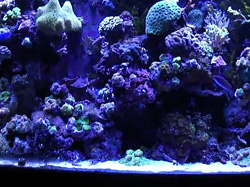 Pictured to the left is an aquarium with the AI Sol Super Blue
Pictured to the left is an aquarium with the AI Sol Super Blue
*Aqua Illumination Vega:
* Review-
This is a really clever & unique concept as per the controller.
Here is a quote from Aqua Illumination’s website:
“With built-in wireless control capabilities you can connect wirelessly to the New Controller or upcoming Director platform with ease and freedom”
One of the most innovative controllers that is chock full of features, including the future “Director”!
The obvious negatives is that while this is an LED light fixture, which is feature rich with lots of bells & whistles, it still lacks where it counts in Useful Light Energy!
Note that while this is one of the better spectrographs demonstrating PUR compared to many aquarium LED fixtures offerings, which is why this is one of the better LED fixtures, one has to question the use of the generic cool white emitters, which can be shown to have more wasted light energy in the middle spectrum as well as the use of less efficient green emitters.
This equals as much as 30% of wattage input goes as light energy OUTSIDE of optimum PUR!!!
* Specifications-
Vega Color
4 – Cree XM-L Cool White
4 – Cree XP-E Royal Blue
4 – Cree XP-E Blue
4 – OSRAM OSLON Deep Blue
2 – Cree XP-E Green
2 – OSRAM OSLON Deep Red
Vega Blue
4 – Cree XM-L Cool White
8 – Cree XP-E Royal Blue
4 – Cree XP-E Blue
4 – OSRAM OSLON Deep Blue
This fixture has be discounted from the manufacture.
*Aqua Illumination Hydra FiftyTwo/TwentySix HD (Hyper Drive):
* Review-
This is one of Aqua Illuminations newer offerings.
A nicely made and excellent “high end” LED fixture that steps up from previous offerings with this 90 & 135 Watt LED Fixture.
This Hydra Fifty-Two and TwentySix new HD has a very eye pleasing color balance, which along their sleek design and balanced 80 degree optics with 90% optical efficiency are their main selling points.
This includes the Osram Oslon Deep Red emitters which do a nice job balancing the many blue emitters.
Nice FULL feature light color control, quoting Aqua Illuminations: “With traditional LED lighting, there is a fixed total amount of power per color you can utilize to power your LEDs. With the Hydra HD Series from AI we’re unleashing your LEDs’ full potential by giving back control of the power to you”.
The Hydra HDs have built-in WiFi control with AiFi Technology with no separate controller needed. Your Smart Phone iOS, Android, or computer browser control functions – Each press will change the intensity by 20%.
This feature is both a positive and negative depending upon your point of view, as this is definitely not a plug and play LED, as you need to sync your wireless computer or Smart phone before you can even run the light at all, however many might find this feature very practical [I personally prefer a separate controller such as with the iLumenAir/ZetLight or one that can ALSO be synced with your computer/Smart Phone such as the TMC AquaRay].
These new HD Hydras can be run up to 90 watts for the Twenty-Six (135 watts for the Fifty-Two). With the HD Hydras, you can turn down one color and hydper drive another at more than 100% up to the maximum wattage. As a comparison, the iLumenAir/ZetLight/Maxspect when turned down on a certain color, these cannot be brought up in another color over 100%.
As an example, some of the blues can be turned down and then run more of the red colors for a planted freshwater aquarium at more than 100%.
Below is a screen shot of how the controller feature appears on a PC computer:
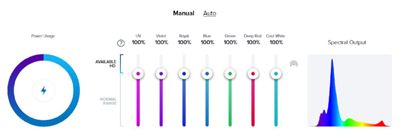
The compact size is also very nice at only 7.28 in. by 5.375 in. for the Twenty-Six HD.
This can allow for placing of many of the Twenty-Six HDs [my preference over the Fifty-Two] in a small space which is a major plus for those who like to over drive their planted or reef aquarium.
A few minor negatives:
- The wireless controlling features are also nice, although lacking of more efficient heat loss reducing PWM, hence the need for a fan.
- These LED fixtures still use “binned” Cree XP-G2 Cool White LED emitters, which is inferior aquarium lighting PUR/PAS, as it has lower kelvin color temperature rating than is considered best for marine reef lighting.
- The LED uses green emitters, which while these are nice for color, these also considerably lower the important PUR & PAS output.
- I also question the use of 400 nm emitters as while these may look nice, I do know from others use of UVA lights, that some burning of corals has occurred (No evidence that this will occur with these LED lights). There is little evidence these 400nm emitters provide much if any useful PAS to corals.
- The new unique “Hyper Drive” feature that uses software to over drive emitters with left over voltage from emitters “turned down” is something that over time will damage emitters as per the known aspects of voltage tolerances within emitters; hence the one year warranty.
So while a very cool/desirable feature, this feature also has its definite down side. - The Hydra HD are not really “Plug & Play” from the aspect that no real mounting hardware is included. So you either have to DIY in mounting or buy extra parts [actually DIY mounting is not that difficult for this fixture if reasonably handy].
When all is considered, including price, the AI Hydra HDs definitely rank among the best of the high-end aquarium LED fixtures and for those who might want to over-drive their planted or reef aquarium, this would probably be my first choice of any current LED fixture.
However for most high end users desiring more “normal” reef or planted aquariums, but desiring what I would still consider more gimmicky feature of driving specific colored emitters at different levels, the iLumenAir/ZetLight would be my choice [the iLumenAir/ZetLight is also is much more of a plug and play fixture and includes very practical mounting hardware].
For those who want a simple proven, pre-tuned LED, with high PUR and output light for input energy, PWM, the longest warranty including more specific pre-tuned light choices; whether it be for their fish, high light planted or reef aquarium that includes some basic mounting hardware, my choice is the AAP AquaRay Lighting line.
* Specifications-
AI Hydra FiftyTwo:
12 – Cree XP-G2 Cool White (> 70 CRI)
12 – Cree XT-E Royal Blue
12 – Cree XP-E2 Blue
4 – OSRAM OSLON Deep Red
4 – Cree XP-E2 Green
4 – SemiLED 415nm
4 – SemiLED 400nm
The Aqua Illuminations TwentySix is similar to the FiftySix except with half of the same emitters.
AI Hydra TwentySix:
6 – Cree XP-G2 Cool White (> 70 CRI)
6 – Cree XT-E Royal Blue
6 – Cree XP-E2 Blue
2 – OSRAM OSLON Deep Red
2 – Cree XP-E2 Green
2 – SemiLED 415nm
2 – SemiLED 400nm
* Input/Output Energy
FiftyTwo:
PSU Input- 100 to 240VAC / 50-60Hz
PSU Output-
135 Watt
TwentySix:
PSU Input- 100 to 240VAC / 50-60Hz
PSU Output-
90 Watt
–PAR: peak PAR of 304 µMol [See Resource]
–Spectrum:
Here’s the excellent, but not optimal in my opinion spectrogram for both AI LED Fixtures run at 100% on all emitters:

–Kelvin: [See Resource]
* Circuity/Dimming-
Dimming capable. 0-10 V
* Spread- [See Resource]
* Waterproof- N/A
* Features-
Greater PAR
Multi Channel
Built-in Wi-Fi, wireless controller. Smart phone or computer
* Mounting- None, extra purchase but still DIY mounting not too difficult
* Warranty-
1 Year (with certain sellers in the UK providing a 2 year warranty at their expense) w/ Register
* Resources-
AI Hydra Series LED
* Coloration-

Below is a video reviewing the AI HD

AI HD Review
To purchase:
Aqua Illuminations Hydra Twenty Six HD
References:
*0-10V Current Reduction Versus Pulse Width Modulation
*PUR versus PAR in Aquarium Lighting
*Aqua Illumination Prime:
* Review-
Newest in the AI line up. A “one fixture to rule them all”. Coming in at 50 watts, with some nice user features like the newest wi-fi controller. Color control for appearance of one’s choosing.
The wireless controller does imply 0-10v dimming along will more color emitters added up to make the overall spectrum.
* Specifications-
4 – Cree XP-G2 Cool White (> 70 CRI)
1 – OSRAM OSLON Deep Red
1 – Cree XP-E2 Green
3 – Cree XP-E2 Blue
2 – OSRAM SQUARE Deep Blue
1 – SemiLED 415nm Violet
1 – SemiLED 405nm UV
* Input/Output Energy
PSU Input- 100 to 240VAC / 50-60Hz
PSU Output-
50 Watts
–PAR: 260 uMol at 12 inch [See Resource]
–Spectrum: [See Resource]
–Kelvin: [See Resource]
* Circuity/Dimming-
Dimming capable. 0-10 V
* Spread- [See Resource]
* Waterproof- N/A
* Features-
Built-in Wi-Fi
Slave mode
* Mounting-
Rim or rimless ball valve adjustable mount
* Warranty- 1 Year w/ Register
* Resources-
AI Prime
* Coloration-

My Salty Reef AI Prime
*Current Satellite Freshwater + LED:
* Review-
The Current Satellite Freshwater LED is a relatively new LED sold primarily at discounters such as Amazon or Petco and is quite frankly typical of LED lights sold at discounters in, which it is full of features that appeal to those with little knowledge of aquarium lighting, but are easily marketed to by “bells & whistles”.
The fact these lights get good reviews on Amazon is why consumer reviews such as these are not to be relied upon.
I will use the model #4007 as an example for this review.
This LED is designed for 36”-48” aquariums and uses 25 watts of electricity.
The LED emitters consist of 72 White & 36 RGB (Red, Green, & Blue) emitters.
First the good, this truly is a feature rich freshwater aquarium LED, with a nicely laid out controller.
Into the science of lighting, we see that this light achieves its 6500 Kelvin with no-name emitters. Not even known quality off the shelf Bridgelux or similar, which at least reasonable quality LED fixtures utilize.
To balance out the 25 watts between 108 emitters takes at least a reasonable driver circuitry, which this LED does not do since the emitters are clearly daisy chained together as one would do with Christmas lights. This is in part why the energy output in PAR is so low per wattage input, as compared to non discount LEDs.
The result is uneven voltage which affects the quality of the light spectrum as well as the life of the emitters, hence the poor one year warranty.
Green emitters are used for coloration, but are less useful as per photosynthetic life. The un-balanaced blue emitters can also lead to increased algae growth, in particular black beard algae if there’s an off balance of co2. This is a common problem with many of these low end LED lights marketed for freshwater aquarium keepers by discounters such as PetCo and Amazon.
The picture below shows with just the naked eye the amount of less useful yellow light energy emitted by the Satellite LED in a typical setting:

Now let’s look at typical cost when compared to a couple other freshwater capable LEDs.
At about $105 for the model #4007 you get an LED, which uses 25 watts and can light an aquarium comparable to a 40 watt T8 aquarium light.
This would be reasonable lighting for fish, but far from the best too. More importantly this would NOT be the best light for high light requiring plant growth or to fend off algae.
My point is this is a well marketed LED that unfortunately is promoted in aquarium keeping forums that should know better, which should be avoided if quality and long life of the fixture are at all important to you.
These only have an IP65 water resistance rating, which is terrible for an electronic device that is to be laced over water.
Just based on warranty alone, the end price will actually be higher than a better PUR light quality LED, so your value goes right out the window!
But even up front costs are actually higher when comparing apples to apples, as you would need more than one #4007 25 Watt Satellite that produces 25 PAR to achieve the same results as a AAP GroBeam 12 watt that produces 61 PAR at a similar depth, so in the end the Satellite is not even a good up front value for planted aquarium keepers!!
A couple of references:
Aquarium Lighting Facts & Information- PUR
Algae Control- Aquarium Answers
* Specifications-
#4007 Model number based on length
72 White/36 RGB
25 Watts
* Input/Output Energy
PSU Output- 12 V DC
–PAR: 36 PAR at 12 inch with a VERY POOR PAR efficiency of .69 watt input energy per 1 PAR output [See Resource]
–Spectrum:
–Kelvin:
* Circuity/Dimming-
Dimming capable. 0-10 V
* Spread- [See Resource]
* Waterproof- IP65 Proof
* Features-
Color picking
Color changing effect
Controller
* Mounting-
Sliding docking legs
* Warranty- 1 Year
* Resources-
Current Satellite LED Specs
* Coloration-
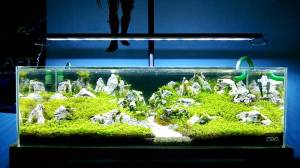
Current Satellite YouTube
*Current Satellite + Pro:
* Review-
* Specifications-
#4012 (model based on length)
30-6500K/14-RGBW, 44 LEDs total
45 Watts
* Input/Output Energy
12 volts DC
–PAR: 100+ @12 with a below average PAR efficiency of .45 watt per 1 PAR output[See Resource]
–Spectrum: [See Resource]
–Kelvin:
* Circuity/Dimming-
Dimming capable. 0-10 V
* Spread- N/A
* Waterproof- IP65 Proof
* Features-
Fully Adjustable RGB+W spectrum
24 hr. timer control for sunrise, sunset, & Moonlight
Automatic 15 min gradual ramp and dim
Six dynamic effects and presets including cloud cover, fading lunar, storm and lightning
Four freshwater optimized preset colors
Wireless programming
Two custom color memory
Controller
aluminum housing
* Mounting-
Sliding docking legs
* Warranty-
* Resources-
Current Satellite Pro Webpage
Current Satellite Pro Sale Sheet
Current Satellite Compare Sheet
*Ecoxotic Stunner/Panorama:
* Review-
The popular “Ecoxotic Stunner” is simply for additional lighting, not Reef or planted freshwater aquarium lighting. The LEDs are not of the output, wattage, or even the same generation technology as the LEDs used by other tech.
As well the PAR output generally is below the necessary PAR required for photosynthesis. Now a days, with new higher PUR tech, something like 20 mmol of PAR is all that is required for photosynthesis. This is with more useful energy in the PAR spectrum (PUR), not just any mmol throughout the whole PAR.
Ecoxotic Panorama Strips have 12 older technology 1 watt emitters (vs. the 2.4 watt high PUR emitters used in other fixtures). More emitters are required due the lack of precision (useful energy output, etc).
That said, while the Ecoxotic Panorama Strips are not top level technology, these are still a big improvement on the “Stunner” and can be considered for Reef Tanks. A popular model is the Panorama Module 8000K/453nm Actinic Blue, which consists of 8 white lights and 4 blue lights.
The newer Ecoxotic Panorama Retro 36 is closer to the higher end LEDs, even then the emitters are still not of the high output useful light energy bins.
Please reference: Aquarium Lighting, Useful Light Energy
Worse is Ecoxotic’s approach to patents for the emitters they are using is “go ahead and sue me”, not the kind of company I think any honest person should support.
There’s a reason that the better LEDs are priced as they are. It’s licensing.
(See Orbital Technologies Corporation Statement; Patent Infringement)
* Specifications-
9 Different Colors
(24) x 453nm Blue
(18) x 8K White & 6 x 453nm Blue
(24) x 8K White
(24) x 403nm Ultraviolet
(24) x Magenta Purple/Pink
(16) x Magenta & 8 x 12K White
(24) x 445nm Royal Blue
(16) x 445nm Royal Blue & 8 x 12K White
(16) x 445nm Royal Blue & 8 x Magenta
* Input/Output Energy
6 Watt
PSU 100-120V
50/60 Hz
* Waterproof-
Water resistant
* Mounting-
Adhesive Tape, Clips, or Screws
* Warranty- 1 Year
* Resources-
Ecoxotic Stunner LED
* Coloration-

Marine Aquarium SA- Ecoxotic LED
*Marineland Reef Capable, Single & Double Bright:
* Review-
The over hyped Marineland Double Bright LED lights from Marineland are also purely for highlighting fish only or complimenting other lights.
As with the Ecoxotic Stunner, these are much older “cheap” technology LED emitters of 1 watt each that do not come close in lumen, focused lumen and PAR output as the newer technology LEDs.
 The so-called “Reef Capable” LED’s by Marineland, albeit much better than the Double or Single Bright, are still 2 generations behind the emitters used by the other newer generation lights, which utilize the best emitters, the best drivers, and PWM technology.
The so-called “Reef Capable” LED’s by Marineland, albeit much better than the Double or Single Bright, are still 2 generations behind the emitters used by the other newer generation lights, which utilize the best emitters, the best drivers, and PWM technology.
These Marineland LED’s have a PAR reading, with the newer Apogee PAR meter, above 80 umol at a distance of 18 inches, but this is not the full story.
Since it’s useful light energy (PUR), which is MOST important and this Marine “Reef Capable” LED with its 21 inferior one watt emitters is severely lacking here.
Please Reference: Aquarium Lighting; Measuring PAR & Aquarium Lighting- Useful Light Energy
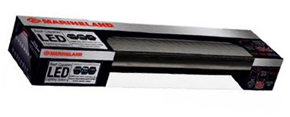 While the “Reef Capable” are what they say they are in being capable of keeping some photosynthetic reef life, their 21 one watt emitters (on the 18-24″ model) are not of the best PUR available in the better newest generation emitters and yet the Marineland “Reef Capable” are about the same price as the vastly superior LEDs. In fact, using 30 watts of input energy of high output emitters will well out produce the largest Marineland Reef Capable with its 54 one watt low PUR emitters.
While the “Reef Capable” are what they say they are in being capable of keeping some photosynthetic reef life, their 21 one watt emitters (on the 18-24″ model) are not of the best PUR available in the better newest generation emitters and yet the Marineland “Reef Capable” are about the same price as the vastly superior LEDs. In fact, using 30 watts of input energy of high output emitters will well out produce the largest Marineland Reef Capable with its 54 one watt low PUR emitters.
See the picture/graph below, while the spectrum of the light is decent for what we know of PUR, the clear way the LED is driven with low watts emitters does not allow for the extra punch in growth, with the extra intensity of higher driven emitters.
There’s not much information published of the LED, but most likely has about a 12K rating. No information on emitters or drivers used.
*As another update to the Marineland Double and Single Bright LEDs, I met with one of my aquarium maintenance colleagues and discussed the results further and re-examined this LED light in action.
After further examining of the low PAR output Chinese emitters used by Marineland as well getting further expert input that these lights are at best for fish only tanks. Basically, the Marine Single Bright had no more output than an 18″ 15 watt T8 Fluorescent aquarium light and should be sold/purchased as such!
In summary, the Marineland LEDs, whether the Single or Double Bright highlight LEDs or the better “Reef Capable” LEDs are still vastly inferior LEDs sold primarily at only often questionable mass merchandisers such as Pet Mountain.
* Specifications-
Size,1 Watt White LEDs,1 Watt Blue LEDs,Lumens
18″-24″, 51,3,300
24″-36″, 68,4,400
36″-48″, 102,6,600
48″-60″, 135,9,800
* Mounting-
Slide out Mount Arms
* Warranty- 1 Year
* Resources-
DISCONTINUED
*Blue Moon Aquatic 90-watt LED:
* Review-
This is another Asian import along with the TaoTronics (same manufacturer in China), which utilizes older technology in quantity to make up for what it lacks in new emitter technology quality.
As you can see with the picture/diagram below, this LED light is much to heavily weighted in the blue spectrum of light for an accurate PUR (Useful Light Energy).
I would only recommend these LED fixtures as a compliment to 6500K to 10,000K light and even then if you get a great deal, otherwise for 1/3 the wattage you have a much better LED light in better technology.
Reference: Aquarium Lighting- PUR (Useful Light Energy)
The other problem with these two LED Fixtures is the more emitters, the more complex and expensive the drivers, so when you have a fixture such as this TaoTronics or Blue Moon LED with a shotgun approach of emitters yet with essentially no drivers you are essentially stringing hardware store quality LEDs together over your aquarium.

* Specifications-
120 watt, 1 fan
* Circuity/Dimming-
Dimming capable. 0-10 V
* Features-
Color control
* Mounting-
Suspension Kit
* Warranty- 2 Years
* Coloration-
*Evergrow & Ocean Revive LED Aquarium Light- Including the OR-D120
As well as the newer Upgraded Black Box SB Reef Lights LED:
* Review-
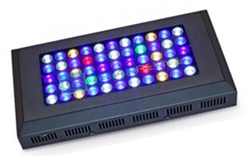 A similar Chinese LED to the Blue Moon and Taotronics, these are another economy LED fixture all made in the same Chinese factory. These are all reef/planted aquarium capable via a higher energy shotgun approach to LED emitters & daisy chained drivers.
A similar Chinese LED to the Blue Moon and Taotronics, these are another economy LED fixture all made in the same Chinese factory. These are all reef/planted aquarium capable via a higher energy shotgun approach to LED emitters & daisy chained drivers.
All three of these LED fixtures are made in China by Chinse company that specializes in branding. Meaning a seller can customize and then re-brand the fixture to fit their marketing niche.
However the guts and concepts are all the same; these are all still lower end low cost LED fixtures that will grow plants & coral well, but are also as much as 1/4 the efficiency of better LED fixtures that better utilize PUR, emitters, drivers and more.
The end result is a most definitely capable LED fixture in the basic as well as customized versions, often with very nice coloration, but also one that when one employs common sense logic, the savings are not what one would think when it requires a 120 watt fixture to do the same job a high end LED could achieve at only 30 watts. Then throw in the lack of water proofing, use of a fan, & other issues that likely will occur once out of warranty and the savings go out the door.
I will start with the newest and very well marketed offering, the SB Reef Light LED.
What the SB Reef offers over the basic Black Box LED is more powerful binned Cree emitters, a larger heat sink and UVA.
However, even on their own website, the USA distributor of this Chinese light is very vague as to real specifications. In reality their web site is all about marketing what “corals crave”, but little real information is provided.
The picture above does clearly show that yellow/amber are used, which are VERY inefficient for photosynthetic light as per the current science of aquarium lighting.
This makes their wave length graph highly suspect, since it shows no yellow light, yet they clearly utilize yellow/amber and cool white emitters!!! Basically this is nothing more than marketing, not science [as the efficiency numbers bear out].
What is also noteworthy is that while many LED lights are coming out with UVA emitters, these are for making our corals, etc. pop with color which is great, but there is little PUR energy with these, meaning wasted energy.
More over, the larger heat sink is required due to the inefficiencies of this fixture both emitter and drivers (typical of the builder), as heat simply equals wasted energy.
As well this black box LED fixture still depends heavily upon fans for cooling and it is not a matter of “if” a fan will fail, but “when” and the end result is over heating and total fixture failure (which has already been reported as per friends in the business and “Bulk Reef Supply”).
Since these lights are overbuilt as per energy used and produced, these often well over produce heat that then needs to be dissipated, even when dimmed since these lights do not utilize PWM.
The terrible efficiency of this over hyped LED shows up when we simply measure the wattage of input energy to product just one micro-mol of PAR. The SB Reef Light, while producing a spectacular PAR that is not even needed for most applications, requires .41 watt of input energy per mm of PAR generated. Even the economy Finnex is lower!!
When dimmed, as most applications require, the lack of PWM means these lights use the same energy input for even less PAR!
These are also not built to IP67 water resistance standards.
While the price is good along with coloration, by the time one figures in that these are only about 1/4 the efficiency of better LED fixtures, any up front savings are out the window. Then, once build quality is factored in, including water resistance, these are NOT a good long term investment.
The SB Reef Light is currently sold and serviced directly from China, but they are setting up a distribution point in the USA with a 2 year warranty.
~~~~~~~~~~~~~~~
The Ocean Revive OR-D120 uses 120 watts to achieve the questionably similar PUR output to a high out 30 watts unit, which defeats the purpose of LED energy savings.
As well these are another LED, which utilizes heat producing, energy wasting 0-10V current reduction technology rather than PWM technology, which is much more energy efficient.
Reference: Aquarium LED Lighting; PWM
While one could argue the green emitters add nice colors, these are less useful lights when it comes to ESSENTIAL PUR.
As well the use of warm while emitters is also very questionable, as no one would ever place neutral or especially a warm white fluorescent light over their reef aquarium, YET it is somehow OK for an LED?
The cool white is also a questionable emitter.
Here are a couple of Spectrograms, which further prove this point, as you can see most of the light energy is NOT within the important spikes required by photosynthetic life, rather mostly in the middle useless nanometer spectrums.


The above said, this IS a reef capable LED light, just at a cost of much more electricity used (& higher carbon footprint), with a much lower PUR as per energy used than the MANY much better LEDs, as well as a much shorter fixture lifespan due to heat damage. But the color mix is nice and pleasing to some, especially those who place appearance over technology.
Some people will claim the addition of these color emitters are for coloration of the corals and prefer color over optimum growth of the specimen.
Please also reference this article:
PUR versus PAR in Aquarium Lighting
* Specifications-
Arctic-T247-B 120W LED Aquarium Light (shipped from China)
2 fan
LED Quantity 48pcs
(2) Red 660nm
(2) Green 520nm
(8) Blue 470nm
(16) Royal Blue 450nm
(6) Violet 420nm
(8) Cool White 12000K
(6) Cool White 10000K
OR-IT2081 240W LED Aquarium Light
3 Fan
LED Quantity 99pcs
(4) Red 660nm
(4) Green 520nm
(32) Blue 470nm
(19) Royal Blue 450nm
(4) Violet 420nm
(24) Cool White 12000K
(12) Neutral White 7500K
Arctic-S026 120W LED Aquarium Light
2 fan
LED Quantity 48pcs
(2) Red 660nm
(2) Green 520nm
(8) Blue 470nm
(16) Royal Blue 450nm
(6) Violet 420nm
(6) Cool White 12000K
(6) Cool White 10000K
OR-IT2040 120W LED Aquarium Light
2 fan
LED Quantity 55pcs
(2) Red 660nm
(2) Green 520nm
(4) Violet 420nm
(6) Neutral White 7500K
(8) Blue 470nm
(21) Royal Blue 450nm
(12) Cool White 12000K
* Input/Output Energy
–PAR: 90-300 umols [See Resource]
–Spectrum: N/A
–Kelvin: N/A
* Circuity/Dimming-
Dimming capable. 0-10 V
Upgraded Drivers
* Spread- [See Resource]
* Waterproof-N/A
* Features-
Sunrise/SunSet/Moonlight
Controller
Coloration control
Touch Screen/LCD
Manual Intensity Control
B/W Control
Built in plug-in
* Mounting-
Bracket or Hanging Kit
* Warranty- 1 Year for Evergrow & Ocean Revive and 2 years for the SB Reef Lights LED
* Resources-
OceanRevive LED
Arctic-T247 120W
OR-IT2081 240W
Arctic-S026 120W
OR-IT2040 120W
* Coloration-
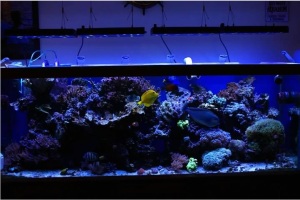
Reef Central Ocean Revive Arctic T247
*EcoTech Radion:
* Review-
This is a very nicely built LED with lots of interesting features, however when it gets down to the important PUR (Useful Light Energy) and warranty, this LED falls short.
A video promoting this, which missed a key point in my experience/opinion, where he only used a PAR meter which does not show PUR, which is MOST important and requires a spectrograph to show more correctly.
Please Reference: Aquarium Lighting; Measuring PAR
This video review did show the Radion can and DOES maintain corals, but it’s still using somewhat of the “shotgun approach” instead of a direct approach of specific LED emitters and use of PWM technology, which in the end requires about twice the wattage input for the same PUR results.
By “shotgun approach” I mean the common way in the past of lighting aquariums with multiple lamps using T8 or T12 bulbs to obtain the necessary light energy for photosynthetic life rather than specific light nanometers [this is not to say the EcoTech are even close to a T8 or T12 lamp, as they are vastly superior, this is only used as an analogy].
An example of what I mean, are the cool white and green emitters used, see below.
See the Spectrograph below to see why:

The EcoTech Radion, emits a significant percentage of its light in the blue as well as some green, yellow, & red spectrums
This is certainly a nice mix of Blue emitters with both the XP and XT, albeit generic emitter bins from Cree. The Indigo and Ultraviolet emitters certainly add nicely to the blue mix.
The mix of Blues is probably the best aspect of the EcoTech Radion, and why when compared to the AI Sol, I would pick the the EcoTech for any tank over 20 inches in depth when compared to the Aqua Illuminations.
The overall spectrum is probably one of the best, comparable to the TMC AquaRay Reef White NP 2000 Ultima
See this article for a Spectrograph comparing the Cree Blue emitters (although the ones used in this article are not generic off the shelf Cree emitters):
PUR vs PAR in Aquarium Lighting; Including Spectrographs
The use of cool white and green emitters is questionable as per references cited here and elsewhere in this article, as well as other researched articles.
I also mildly question the use of Red emitters for Reef Lighting applications, since symbiotic photosynthetic zooanthellic have adapted over eons to the more blue environment of the oceans versus photosynthetic “higher” plants found in freshwater applications.
From discussions with other reef keepers, they have not noted any improvement with added red lighting and in fact have anecdotally noted slower coral growth.
The other misleading aspects are the completely useless RGB and capacitive touch ‘features’. Controlling your RGB (Red, Green, Blue) of your light has little bearing on obtaining the exacting nanometer spikes necessary for photosynthetic life.
There’s no known benefit from the RGB feature and in fact some reviews state this can be stressful/harmful to coral. The reason is above spectrograph output only holds true when the emitters are run at the operating voltage and current that they were designed for unless PWM is employed. As soon as that simple voltage rheostat is used (“control technology”) or RGB is altered, the spectral output changes.
As noted in other articles cited/referenced here, the emitter choice is just part of the LED equation, the use of “Current Reduction” instead of the vastly superior PWM technology is a major drawback of the EcoTech Radion.
The evidence is the requirement of a cooling fan, which can break down from the heat produced. As well the placement of the fan tends to draw moisture into the fixture which is a complaint of many reef keeping professionals. One reason for the 1 year warranty offered by EcoTech in my opinion!.
Further Reference: Radion XR30w Gen 2 Fan Failure.
More importantly, the excess heat which requires a cooling fan also represents a considerable amount of lost input energy to heat that could be going to lighting your aquarium reef specimens. This is NOT an opinion either, as it is basic science that energy going to produce heat is energy NOT going to light!
Another evidence is that the Radion Pro produces 1100 µMol•m²•sec PAR from 155 watts of input energy at 6 inches of air, but when compared to the before mentioned AquaRay Reef White 2000 NP Ultima, the AquaRay is rated at 380 µMol•m²•sec at 15 inches of air.
Just assuming both were at 15 inches of air, so as to compare equally otherwise, when you multiply the 5 AquaRay 2000s at 30 input watts to equal the Radion Pro, you get 1900 µMol•m²•sec. So in other words (using these numbers), just in PAR, you only get half the output per wattage of energy used for the EcoTech when compared to the AquaRay LED.
As well since we were comparing EcoTechs number at 6 inches, and AquRay at 15 inches, this also would increase the AquaRay numbers by even more.
The end result is a fixture that may require about 1.5 watts per gallon to light an advanced reef tank compared to .8 watt for, as an example, the AquaRay Ultima.
What I have noted from my own research and that of my aquarium design & maintenance friends is that the EcoTech Radion is well marketed to the point that many if not most forums and aquarium stores assume this is the best LED available when although excellent, it is not necessarily the best as per reasons and research cited here.
Even EcoTech’s own customer service [according to a friend who forwarded me an email] will refer questions about their product to forums.
See this quote:
“I would recommend doing a search in some online reef forums”
So, all I ask is that one does there research, do not just take my word, as while these are certainly an excellent reef capable LED light, these are not necessarily the best. The bells and whistles also certainly may be what one buyer would desire, but another buyer might prefer an equally reef capable LED that is more efficient with less energy lost to heat or used as green light energy (that has no known PUR benefit).
In fact as per electrical saving alone, this fixture will cost you $62 more per year based on running at 12 hours per day and with an average electrical cost of .13 per kWh. Factor in the one year warranty and lower lifespan (1 year warranty) and this can be a very expensive Reef Aquarium LED to purchase and keep over time!!
Finally as per a comment asking me to back up my claims with data, while I cited references throughout this article, the above three, which includes my base article about LEDs, are also now added just above.
As well as the Radions own data as per emitters used, simply reading the references and combining this with the Radions own published emitters pretty much backs up my statements, not to mention hands on use by others I know and the second reference above.
CRI is also often cited as a selling point for the EcoTech, however this is not a parameter a reef keeper needs to be concerned with as this is for human lighting; see Aquarium Lighting- CRI
Update:
TMC had a quality control failure in 2012 where-by these same cool white Cree emitters from EcoTech were used in their Ocean White 1500 XG fixtures instead of the correct patented XPG 9000-10000k emitters.
What is interesting is this mistake was caught by knowledgeable customers, one of whom made a spectrograph so as to back up their claim that these were not the correct emitters.
Why I find this interesting and why I post this in the review of the EcoTech LED is that those with reasonable knowledge of “Useful Light Energy” easily spotted this problem, yet based on friends in the retail industry and others will argue about CRee licensing while missing this very simple and basic problem with the LEDs using Cool White emitters.
* Specifications-
Radion XR15 Freshwater Water
60 watt, 1 fan
LED Quantity 15
(5) Neutral White
(2) Deep Blue
(2) Blue
(2) Green
(2) Hyper Red
(1) Indigo
(1) UV
Radion XR15w Pro
75 watt, 1 fan
LED Quantity 15
(4) Cool White: Cree XP-G2 (20W)
(4) Deep Blue: Osram Oslon Square (20W)
(4) Blue: Cree XP-E (12W)
(2) Green: Cree XP-E Green (7W)
(2) Hyper Red: Osram Oslon SSL (6W)
(2) Yellow: Osram Oslon SSL (3W)
(1) Indigo: SemiLEDs (5W)
(2) UV: SemiLEDs (5W)
Radion XR30w
150 watt, 1 fan
LED Quantity 38
(8) Cool White: Cree XT-E (40W)
(6) Deep Blue: Osram Oslon Square (24W)
(8) Blue: Cree XP-E (24W)
(4) Green: Cree XP-E Green (14W)
(4) Hyper Red: Osram Oslon SSL (12W)
(4) Indigo: SemiLEDs (10W)
(4) UV: SemiLEDs (10W)
Radion XR30w Pro
170 watt, 1 fan
LED Quantity 42
(8) Cool White: Cree XP-G2 (40W)
(8) Deep Blue: Osram Oslon Square (40W )
(8) Blue: Cree XP-E (24W)
(4) Green: Cree XP-E (14W)
(4) Hyper Red: Osram Oslon SSL (12W)
(2) Yellow: Osram Oslon SSL (6W)
(4) Indigo: SemiLEDs (10W)
(4) UV: SemiLEDs (10W)
* Input/Output Energy
110-240V
115VAC, 3.5A; 240VAC, 1.8A; 50/60 Hz
–PAR: [See Resource]
–Spectrum: [See Resource]
–Kelvin: Custom
* Circuity/Dimming-
Dimming capable. 0-10 V
Drivers
* Spread- [See Resource]
* Waterproof- IP rated fan
* Features-
Full Spectrum + UV
Preconfigured outputs matching popular Kelvin ratings
24-hour customizable program schedule
Multi Channel
Independent day and night periods with lunar calendar
Acclimation mode for ease of integration with aquarium
Weather condition simulation; sunrise, sunset, clouds and lightning
Wireless Control Capable
EcoSmart Live
IP Rated Fan (Certain Model)
TIR Lenses
* Mounting-
adjustable base bracket
* Warranty- 1 Year
* Resources-
radion-xr15-freshwater
radion-xr15w-Pro
radion-xr30w
radion-xr30w-Pro
See also:
*Ecotech Marine’s Radion XR30 LED Light: a Swing and a Miss?
*Aquarium Lighting- Facts & Information
*Aquarium LED Lights, Lighting
*Aquarium LED Lights, Controllers, PWM- What is Best
* Coloration-
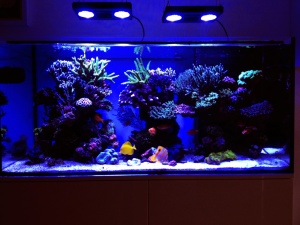
I Love Reefing- EcoTech Radion
*Kessil Freshwater & Saltwater
* Review-
The Kessil Reef & Planted Aquarium Capable LED light is popular among many deeper reef aquarium keepers.
However marketing has driven many, including prominent YouTubers, to think these are better lights than they actually are.
This is a very sleek and compact LED light, one of the better ones in my opinion. The Kessil LEDs also use patented emitters.
Kessil’s emitters are patented Dense Matrix LED™ technology which concentrates multiple LED chips into an array.
The Kessil A360W (the ‘W’ is for wide angle) is their flagship as of the most recent revision of this article.
Multiple Kessil A360Ws can be controlled with a single Apex Controller—two channels are required for each Kessil controlled. Future versions of the Apex Controller software will add functionality to the Kessil A360W. An example of this added functionality is a more gradual dimming and color shift.
The A360W still has the two knobs, just like the A350W. But instead of one knob controlling the blue LEDs and the second knob controlling the white LEDs, one knob is used to control overall intensity and the other knob the blue/white LED spectrum mix. You can tune a preferred color within the spectral range thousands of research and testing hours determined to be the optimal spectral points.
The A360W is a wide angle model has a beam spread of 70 degrees vertically (140 degrees edge-to-edge) and is recommended for larger tanks that are relatively shallow while the Kessil A160WE Coverage Area is up to 24″ surface diameter for fish-only/soft corals and up to 18″ surface diameter for mixed reef with LPS or SPS corals.
The Kessil A360W is 90 Watts with an effective light greater than a 250 watt metal halide while the Kessil A160WE is 40 Watts.
Now some of the the negatives, based on the known science of lighting:
- The adjustable feature that is cool to most aquarium keepers is also degrading to effective PUR, as while it is nice to have these features from our perspective, the simple fact is what you or I might like is not often what is the optimum PUR.
As well, as with the AI and many other “tunable” LEDs, when adjusting your light spectrum, your LEDs full potential is wasted. This results (as an example) in a 90 watt LED becoming 60 watt LED or less, so PAR output is also considerably degraded.In the end you are much better off with a proven fixed PUR spectrum set from the factory rather than a blend of “tunable” emitter colors.
Reference: PUR vs PAR in Aquarium Lighting (LED); Fresh & Saltwater (Reef)
- The amount of energy wasted as heat is still high due in part to its features such as use of tuning without PWM, hence the need for a cooling fan. This is also why the Kessil A360W only replaces a 250 watt MH when higher PUR per watt, Other LEDs can accomplish this with half the wattage.
- Kessil refuses to publish any PAR readings which while PUR is certainly a a consideration, PAR is still the standard measurement to start with. As well, since we already know their spectral quality is suspect, it is difficult for Kessil to hang their hat on PUR to make up for poor PAR readings, especially outside the direct central of their lights.
This answer from Kessil is rather alarming:
“At this time we do not have any published information about light output. PAR is not an accurate measurement for measuring light using LEDs because it only includes visible light, and does not distinguish between usable and non-usable wavelengths. ”
ACTUALLY PAR measure mostly inside the usable spectrum, it simply falls off toward the blue & red ends, meaning a PAR reading of a LED that is mostly blue that has everything else the same [including input wattage] is going to be lower.When we measure the Kessil A150 (90 Watt) which I have firm PAR readings directly under at 15 inches of air [not water which can throw some variables] we get 325 µMol•m²•sec.
While this is certainly a good number as per raw PAR, but when we factor in that this is only directly under the light and this is at a full 90 watts of input energy, this is actually a very inefficient LED light as this is .28 watt of input energy per mm of PAR.
By comparison the AAP/TMC Reef White 2000 has a PAR of 380 uEinsteins/sec/m2 @15 inches of air using ONE THIRD THE INPUT ENERGY [30 watts]. This is .08 watt of input energy per mm of PAR, TRIPLE THE PAR OUTPUT PER WATT!
This does not even factor in the better spectral quality, making the Kessil a very suspect aquarium LED for the price paid IMHO!In my opinion, it is unfortunate that so many planted and reef keeping gurus hang their hats on these good, but far from the best LEDs. The only logic I can see outside of brilliant marketing is the sleek looks.
* Specifications-
* Input/Output Energy
PSU Input 100-240V AC
PSU Output 24V DC
Freshwater
A150WE Amazon Sun
6700K non descript emitters
34 watt, 1 fan
A160WE Tuna Sun
6,000-9,000K Tunable non descript emitters
40 watt, 1 fan
A360WE Tuna Sun
6,000-9,000K Tunable non descript emitters
90 watt, 1 fan
Saltwater
A150W Tuna Blue
34 watt, 1 fan
A160WE Tuna Blue
40 watt, 1 fan
A350/A350W Tuna Blue
90 watt, 1 fan
A360N/A360W Tuna Blue
90 watt, 1 fan
New LED Design
AP700
185 watt, 1 fan
Power Converter
–PAR: N/A
–Spectrum: [See Resource]
–Kelvin: [See Resource]
* Circuity/Dimming-
Dimming capable. 0-10 V
Drivers
* Spread- [See Resource]
* Waterproof- N/A
* Features-
Manufacture LEDs in-house
Penetration
Shimmer
Double Peak Spectrum (PAS)
Color Mix
Intensity Control
Daisy-chain multiple
UV Spectrum
Channels
Master Salve (A360)
WiFi (AP700)
* Mounting-
Mounting Brackets
* Warranty- 1 Year
* Resources-
Kessil LED Lights
Kessil Failures
QUOTE: “I figure there are a lot of Kessil users here on R2R. Am curious, with regard to the A360WE, what folks experiences have been with longevity. I have a bunch of them on my system and have not been particularly happy with them from a reliability perspective. Kessil is very good about the warranty (and I had two fail under warranty), but I’ve now had my first fail outside of the warranty and am trying to decide how to proceed. 2-3 years from a $400 (now $350) light just seem quite poor to me, but perhaps I am just unlucky. I clean them out regularly. Anyhow, would be interested to hear how long folks have been running these lights and whether you have had failures.”
* Coloration-
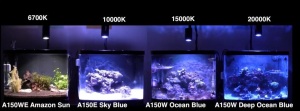
Kessil Led’s – Meet The Family
*E.Shine, Stark LED:
* Review-
E.Shine is a large producer of LED Fixtures, which are probably among the nicer design and generally better quality LEDs coming out of China.
E.Shine often does not sell directly under their name, rather they market to retailers and distributors for their own branding.
Stark LED (distributed by Sea Dwelling Creatures of LA) is probably the most common marketer of this LED Fixture.
While E-Shine has updated their emitter bins, they remain behind the industry leaders as E.Shine utilizes common “binned” Cree & Bridgelux emitters, often a generation or two back at that.
In fact even E.Shine’s own web site admits that the older generation 3 watt CREE XG used for their COOL WHITE Daylight Aquarium LED Lights vary from 8000~10,000K; not the exacting emitters used by high end LED fixtures that target specific nanometer wavelengths for the best PUR.
Reference: e-Shine 60 Watt Cree Classic LED.
Please note that these are cool white emitters. Would you go to the hardware store and place a cool white lamp over your reef tank?
These emitters used by E.shine do NOT maintain the peak PUR necessary for delicate marine life, and instead have much more wasted yellow and green wavelengths due to use of cool white and green emitters.
It is also noteworthy that ALL E.Shine LEDs require a fan, some more than one at that. A proper driver along with PWM does not require a fan due to better control of voltage between the emitters, notwithstanding, spikes in voltage which decay PUR show up as excess heat!!
Also please read this article:
PUR vs PAR in Reef, Planted Aquariums Lights
E.Shine does a great job “pushing” these LEDs on companies looking to sell a nice looking product at a VERY good mark up, as I know of a friend in the business that gets these LEDs constantly marketed to him at prices that would allow for much better margins (since the emitters are low cost generic Cree emitters). However he has rejected these out of integrity to sell the best generation LEDs, even if the profit margins are lower.
One plus is E-Shine has increased their warranty to 3 years for most fixtures. From input of those using these products longer term, e-Shine has basically used the same design and technology, keeping development costs down while also improving quality control, thus the better warranty.
In the end with eShine, you get a very energy wasting, but still reef capable LED of older technologies, and with a good price and good warranty.
* Circuity/Dimming-
Dimming capable. 0-10 V
* Waterproof- N/A
* Warranty- 1-3 Years
* Coloration-

E Shine LED Systems
*Other LED Aquarium Lights (such as the Boost LED, Orphek):
There are many other LED lights coming fast onto the market, occasionally excellent, many good, many not so good, some a downright rip-off!
Knowing about what makes for correct Aquarium Lighting is quite helpful in making an informed decision.
Please reference: Aquarium Lights Facts and Information- Correct lighting
I would also stress that even among the more effective new LEDs hitting the market, such as the BoostLED, these all have to compensate for inferior emitters with high amounts of wattage used, which in my humble opinion defeats a primary reason to use quality LED lighting for your Reef or planted freshwater aquarium; lower electrical consumption per output of useful light energy!.
Using 4.5 times the energy (wattage) to produce only 30% more PAR, as in the BoostLED versus other tech, makes little sense to me or most aquarium professionals I have spoken with seeking the best lighting for their clients. This “shotgun” approach to aquarium lighting defeats the reasons to use LED lights [energy savings], one might as well use a good 150 Watt Metal Halide rather than a 135 Watt LED.
A Few decades ago, the “shotgun approach” is all many aquarium keepers of high light planted or basic reef tanks had as per comments by a 35 plus year aquarium professional I interviewed. So using eight 48 inch 40 watt “cool white” T12 lights to light one 60 gallon aquarium was sometimes necessary, but this is not necessary with many modern lights, so why go backwards when the technology is here?
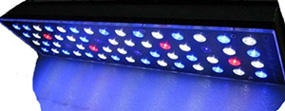 For an example of a newer “excellent” LED Aquarium Light is the “Orphek Nilus Reef Aquarium LED Light” which is equal to a 250w-400w MH/HPS light.
For an example of a newer “excellent” LED Aquarium Light is the “Orphek Nilus Reef Aquarium LED Light” which is equal to a 250w-400w MH/HPS light.
The Orphek Nilus 120 watt LED light contains 60 LEDs in 90 degree lenses running at 2 watts each within a 24″x 6″ x 2″ housing.
This LED has (4) innovative “True Violet” 380nm – 420nm emitters (excellent for 30″ + tanks) as well as (4) 640 nm red emitters (which are nice for coral color aesthetics, but little to no effective PUR use in tanks over 18 inches of depth).
Other emitters include (3) 14,000K-16,000K White emitters and (22) Royal Blue 450nm – 470nm emitters
This LED is quite expensive (over $800), however it is designed for tanks over 30 inches in depth [replacing Metal Halides]. The overall color temperature is about 16,000k.
The spectral range is greater than the common Cree or Luxeon LEDs used in many LED fixtures, starting at just around 400nm (violet) and spanning all of the way to 750nm.
This is a top notch LED Aquarium Light for deep reef tanks, however I do not agree with a couple aspects of this design of this light and that is its emphasis on CRI (Color Rendering Index), as this is more important to what we see and not what the symbiotic zooanthellic algae within corals actually require. As well the Orphek white emitters are 12000K to 25000k leaving out much of the essential near infrared.
Please reference: Aquarium Lighting; CRI (Color Rendering Index)
While I realize that the popular fad of fading/dimming LEDs for sunrise/sunset is simply that; a fad as there is no scientific basis that this aids corals, I also do not agree with Orphek’s use of “blue” lights for moon light phase, which is also just a fad with no scientific basis in fact.
So once you get past the hype, this is still an excellent LED for those with deep tanks that may otherwise use a 400 Watt 20,000K MH, assuming you can even obtain these LED Aquarium Lights, however based on Orphek’s own data, this is NOT an LED fixture for tanks under 24 inches in depth
LED REVIEW SUMMARY
Emitter bins used in LED Lights are improving rapidly, although I am sure at some point these will hit the technology ceiling.
In the mean time, one can be certain of one thing, the best emitters are going to be licensed/patented and one is not going to find these in many of the cheapie knock offs. Even many of the “better” LEDs may use the newest emitter bins, but these are still “over the counter” emitter bins meant for many uses, not necessarily aquarium lighting and these bins generally aimed at higher CRI rather than the much more important PUR.
Another issue is that some companies are practicing patent infringement to close this technology gap. Purchasing these LED Aquarium Lights is not only a moral decision, but also many of these “stolen technology” LEDs are cheaply made and once these LEDs are legally closed down, the person who did not care about the moral issue, will likely face the problem of a light that fails to work long term with no customer support. This will result in these knock off LEDs being useless and not the bargain one might think when purchasing.
Finally, also realize the most important light measurement is “Useful Light Energy” or PUR and although I recommend the use of PAR Meters as a measurement of any aquarium lighting fixture, in the end this FAR from 100% accurate, especially when one considers the emitter bins used, and useless PUR emitter colors such as green. Often the “cheap” LEDs produce considerably more useless green/yellow light and are bottom heavy in the Blue Spectrum.
So, consider whether your so-called “deal” of a LED Light is really a deal at all or look at it this way: would you use multiple LED Flashlights you can purchase at Walmart to light your Reef or planted Aquarium? Although this analogy is a bit exaggerated, it is still a reasonable analogy when one considers current technology advances and the costs of developing these advances.
For further Aquarium Lighting information, I strongly suggest reading this long, but in depth article:
* “Aquarium Lighting; Reef, Planted, More”
*PUR/PAS vs PAR in Aquarium Lighting; Including Spectrographs
*ReefTank123; Aquarium Lighting
*Purchase Aquarium LED Lighting; What to Know
While making recommendations, if your aquarium has a UV Sterilizer for Disease Prevention and Redox Balance, I recommend changing your UV-C Bulbs every six months for maximum performance and this and this is the place for premium UV Bulbs:
Ultraviolet Bulbs; page 1
Recommended Reading:

Fish Diseases | How to Treat Sick Fish
Further Product Recommendations:
PREMIUM Aquarium Sponge Filters
Copyright 2020, By Steve Allen

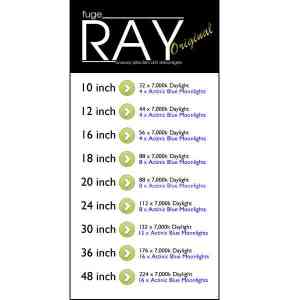

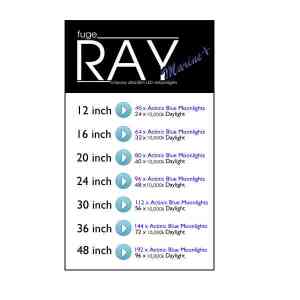

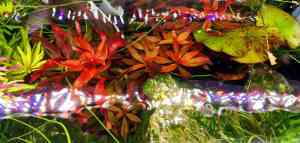

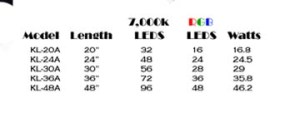

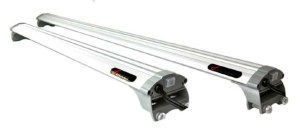
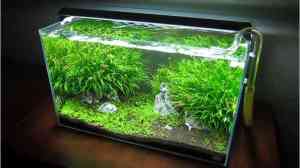






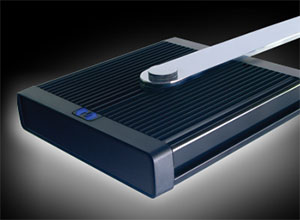

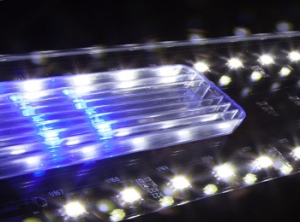
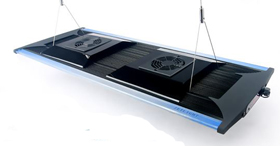



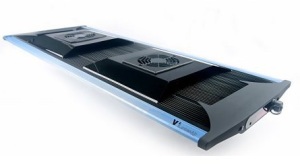
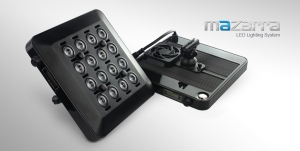


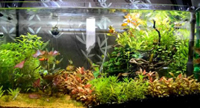

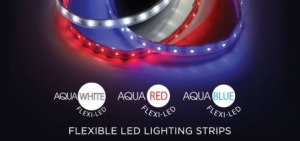
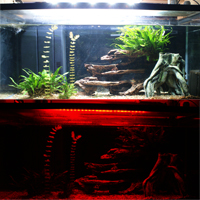
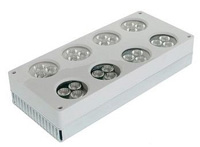


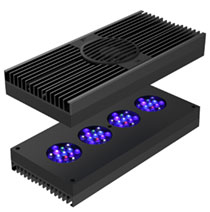


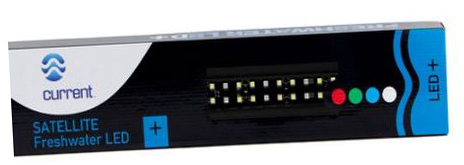


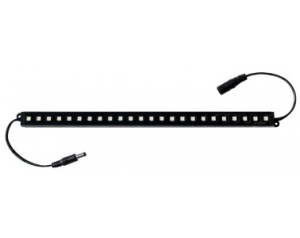






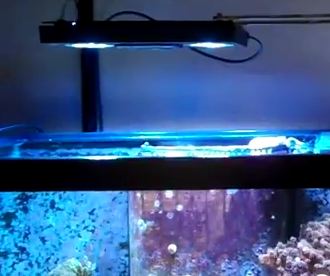
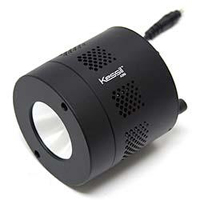
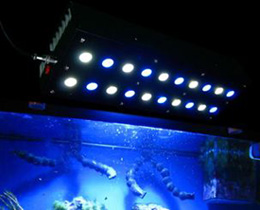
Pingback: LED Aquarium Lights, Lighting « Aquarium Article Digest
Pingback: Aquarium Lighting - Aquarium Supplies, Resources
Pingback: Purchase LED Lighting; What to Know? - Aquarium Supplies, Resources
Pingback: Unique Aquarium Information Articles - Aquarium Supplies, Resources
Pingback: Aquarium LED Light Installation Options. | Aquarium Article Digest
Pingback: AQUARIUM LIGHTING DIGEST; Parameters, Lights Technology | Aquarium Article Digest
Pingback: New Aquarium Light Technology; SHO - Aquarium Supplies, Resources
Pingback: Stark Aquarium LED Review | My Aquarium Opinions
Pingback: TaoTronics, SkyLED LED Light Reviews | My Aquarium Opinions
Pingback: EcoTech and Aqua Illuminations Sol Review | My Aquarium Opinions
Rohan, I do not know who told you this, but they REALLY got their facts wrong. I even looked over at Ultimate Reefs and found mostly positive comments about the AquaRay.
More than likely your phosphates or some other parameter is being missed, or your lights are incorrectly place (although I doubt this).
As per the facts, while the AI Sol and Radions are decent LEDs, when you look at the simple facts that they use cool white, 6500K FW plant lights, green, and red emitters, all from older bins; it is simply not rocket science that these are clearly inferior lights
As well what about the many professionals using the AquaRays in their aquariums without a problem (this just among those I know, not to mention those of a friend who has used 100s)?
Please read these articles for some facts:
https://aquariumdigest.wordpress.com/2010/04/11/led-aquarium-lights-lighting/
http://www.americanaquariumproducts.com/Aquarium_Lighting.html
There are many more articles in internet searches
Very informative article. I have been running a pair of AquaRay 600 Ultra (Reef Blue/Fiji Blue) and a pair of AquaRay 600 Ultra Reef Whites 10 hours a day (with four hours ramp up/down) to replace the 39w Actinic/39w White T5 pair on my 4 foot soft coral and LPS mixed aquarium.
The aquarium also uses 2 * 150w metal halides running for three hours per day. I have a miracle mud refugium which is using a Aquahabitat 400 LED instead of a single T5 to grow Chaeto.
So far, the corals bubble and leather corals are fully expanded, the brain and soft coral polyps look great under the Fiji lighting and, so far, there is not much red slime algae in the refugium. However, with the metal halides off, the tank does look rather blue.
I’m considering what would be best to replace the metal halides, which deliver a good spread of light across the aquarium surface, and easily reach the bottom.The aquarium is 20 inches deep, although most of the corals are at 12-16 inches. From what you have written the Aquabeam 1500XG would work, but I hear many people are using the Aquabeam 1000.
Cliff; The AquaBeam 1000 is still TMCs premier LED (it has been updated multiple times since initial introduction), and would give your best light penetration and is still my preferred LED over the 1500 XG.
The 1500 XGs definitely have better light spread, but if this is not as important or you can afford to cram more intense lights in given space that have a smaller but more intense foot print, the 1000 is for you
Considering your blue hue, and use of blue lights already, I would consider the Marine White 1000
Pingback: Zoanthid Reef Aquarium Lighting & Care - Aquarium Supplies, Resources
Pingback: Republicans or Democrats; Who REALLY is more popular? « C Strohmeyer's Weblog; Life, Business
Pingback: Aqua Illuminations Vega & Reef Lighting | My Aquarium Opinions
Pingback: Aquarium LED Lights, Controllers; What is Best | My Aquarium Opinions
Pingback: Work Newsletter | Life How Devon Know It
Pingback: Review of Ocean Revive & Evergrow LED Lights for Reef Aquariums | My Aquarium Opinions
Pingback: EcoTech and Aqua Illuminations LED Review | My Aquarium Opinions
Does any one know about Aqua Vim LED aquarium lights? I have not found any reviews from aquarium digest and was not listed among other manufacturers.
Pingback: AQUARIUM LIGHTING BASICS; Parameters, Lights Technology | Aquarium Article Digest
Pingback: Vile and Hateful Comments, Member of Reef Central; Magyar | C Strohmeyer's Weblog; Life, Business
These are great informative articles! I learned a lot! But I do not understand? When are YOU going to realize that most people just want to see the colors of their coral and fish look awesome. If the coral does not grow at the maximum possible rate, they do not care. That is one of the reason that people will buy theRradion (Way too expensive for me) vs the TMC lights. SO, knowing that I WANT some green and red color, plus the “pop” of the actinic colors, is there any light out there that has the PUR and PWM of the TMC yet the color of the radion that is pleasing to MY eyes? I will sacrifice PUR for good color… I will even sacrifice wattage for good color. I have a 6′ 180 with three 2′ sections to cover…
Thanks in advance
I do not agree with your premise, as I know plenty of persons that look as fish keeping as a responsibility to do the best we can to keep our specimens/fish healthy.
Most persons I know do care about how their equipment works.
More importantly, you are assuming that theAquaRay lights do not look good, I also disagree with this premise as well. They (AquaRay) also has a Colour Plus LED that can be used as a supplement for more reds and greens. But unlike other sellers, they only consider these mixes of colors a supplement
I agree I do not know that the Aquaray lights do not look good. What would you recommend for a 180 gal (6’W x 2’D x 2’H) with 2 top braces dividing the top into three 2′ by 2′ sections to have no shadows. Note the Colorplus LEd states it is for nano tanks. The Aquabeam 2000 states it provides 18″ x 18″ light spread.
I want to duplicate a 10000K MH look as far as brightness perceived by my eyes, as well as the coral color “pop” that my Actinic03 T5’s produce. I do not like the “dim blueish” color of 20000K bulbs that do not bring out the colors of my fish.
While the purpose of this website is not to give specific recommendations, rather good scientific based information to help readers decide what to get, I will make an exception and answer your specific questions as I feel this might help other readers too.
First let me point out that the Colour Plus is NOT meant for Nano tanks; it is a 24 x 24 inch light spread supplemental light meant to provide the “popping” colors you desire while still provide good, albeit not the best lighting PUR/PAR.
The NP 2000 is meant to provide the BEST PUR at a minimum of energy used in a focused relatively high PAR light
TMC makes these different fixture unlike others (in my opinion) to provide user a CHOICE, rather than try and make a LED fixture that attempts to be all things to all reef aquarium light users.
So my suggestion is one tile of EACH fixture in each section of your Aquarium; this will provide both top notch PUR along with excellent coloration. I would also suggest that you position the NP 2000 over the corals or other specimens that require the most light while you place the Colour Plus in a way to helps provide good over all lighting
Should you feel even more light is need on this aquarium, adding one AquaRay Reef White 600 Ultima to each section would further balance out this lighting and lessen shadows.
I also suggest reading this article:
http://www.aquarium-pond-answers.com/2012/03/pur-vs-par-in-aquarium-lighting.html
Pingback: Marineland leds
Pingback: Very informative article on lighting. GREAT READ!
I really appreciate the in depth scientific facts that are nearly almost always missing from a lot of inline reef forums.
People tend defend what they buy or what they perceive based on hype and a good marketing cam
I have to agree with Robert.
I often cruise several forums, partly from emails some clients and aquarium industry pals send me and often what I read is appalling.
Many will act like its about the science, but in reality the science gets pushed out the door and anyone who challenges get mocked.
Two forums in particular that stand out that I have observed this in is Reef Central and PNWMAS
Pingback: Economy Planted Aquarium LED; Fluval Aqualife & TMC AquaBar | My Aquarium Opinions
Hi, your analysis is really a revelation as I was looking to buy one of the typical top selling/known brands, aqua illumination or ecotech. I had never heard of AquaRay until your review, but now it looks like the best alternative, perhaps except for Kessil??? I was also considering Kessil’s 250 or 360 wides for my 180 gal 6 ft. reef tank.
I’m looking forward to your review of the 250 or 350 Kessil LEDs as the 150 got good marks in your side by side comparison.
Since Kessil is a popular brand and uses advanced technology, I’m hoping you’ll be able to do an analysis soon. Any word on when that might be?
Thanks you again for your great work.
It is unfortunate that many have not heard of the Aqua Ray LED, I have been using these almost exclusively for 4 years now.
Most of the other LEDs I have with my clients are simply ones that came with the aquarium when a client had their aquarium set up or purchased elsewhere.
But what I can tell you is the tanks with the AquaRay present better, and the few times a client has allowed me to change over, they often noticed this too and also noted the lower electrical bill too.
The problem is in my humble opinion that too many persons rely on online forums and discount sellers such as PetCo, Amazon, TruAqua, DR. F&S et al to get their information, then assume that the what is mentioned in what seems to be a looped tape is all there is, when in fact just a little digging, will yield that there is another world of information waiting to be discovered.
My suggestion also is to get away from Google search and the larger aquarium forums and go with Bing, as Google seems to also loop these same old tired information, thus one gets stuck in this circle of bad information.
Here are just a couple of webposts:
Mike, I am glad this helped you.
It is unfortunate you have not heard of AquaRay until now, especially since these have been around longer than the over rated EcoTech and AI LEDs and despite so many of the lemming forum comments have been in professional use at least since 2009.
I do plan to provide information about the Kessil soon, right now it is a matter of double checking information and getting good feedback from the aquarium professionals I consult.
What I can tell you is for deep tanks such as yours, the Kessil has the best lens and would be my recommendations, not the AquaRay.
As for technology, while the Kessil is definitely one of the best, it still does not use the true PWM technology that AquaRay uses and still requires a fan which one of my consultants has told me of a burn out of a Kessil fan. So for tanks under 30 inches, I would recommend the AquaRay NP 2000, but for deeper, the Kessil 360 looks like the better choice based on current data.
Notwithstanding, I am still awaiting more data such as emitters used, etc. before I can make a good analysis
Here is a link to their website:
http://www.kessil.com/aquarium/A360.php
Classification: UNCLASSIFIED Caveats: NONE
Why have you never commented on Aqua Vim lighting which is based in NYC?
Fred
This is an LED that has never been mentioned by any of my contacts and honestly I have never heard of until now.
I can say that I get forwarded emails from Chinese vendors every day where many of the so called new LEDs are simple one of these generic LEDs with a new name slapped on. An example is E-Shine markets this way producing many generic LEDs that local distributors can add their name to, implying that they are the maker when in reality they are not.
Another good example is the Ocean Revive which is marketed in the Pacific Northwest, but in reality is an Evergrow with a new name slapped on
Be careful about saying that the TMC Aquaray line offers a 5-year warranty. They don’t! They offer a 2-year warranty. They will trade a customer for a great deal of the customer’s personal information by extending a partial no-charge replacement/repair option, but that is not a warranty.
Deanna, this is 100% INCORRECT!
I know of two persons in the aquarium trade and have used the AquaRay too. They offer the only 5 year warranty, and even then provide a new replacement. As far as personal information, those whom I do business with handle all the warranty returns in house, without any kind of warranty registration other than keeping computer records of all sales, which are then used for any warranty returns
Wow Deanna! I have been using the AquaRay lights in my aquarium maintenance business for years now and nothing you are saying is true!
Have you been drinking the Reef Central Kool Aid?
Here is another warranty reference:
Pingback: Purchasing Aquarium & Pond Equipment via Amazon | My Aquarium Opinions
Pingback: Technology Review Led | Technology Documents
Pingback: Amazon Reviews for Aquariums | My Aquarium Opinions
One LED I do not see listed here is the “Build My LED”.
I am actually happy to see it missing.
These are decent LEDs, especially for those who like specific colors, but not so much for those seeking the optimum light energy for their plants/coral.
My bigger problem with this company is they have a customer service representative who childishly and disrespectfully trashes a long time author of many excellent aquarium keeping articles, including a few you link to here.
This customer service rep parades as an expert with little long term knowledge or experience.
Worse yet she has allowed comments accusing this author to be compared to a rapist and murderer.
IMO this is a company that should NEVER be patronized and will hopefully either fire this individual or fade into oblivion if their is any positive karma in this world.
Yes, I am aware of this issue.
Hopefully this company will resolve this issue soon as their customer service person is certainly a black eye on the aquarium keeping industry & hobby
Steve – Good writeup! I appreciate the disclosure on adequate scientific equality across the reviews.
I just acquired a R420R 160W 10,000k fitting and thought it prudent to feed back some information as your site was a primary source of info on the purchase decision.
The R420R (At least the R4A10K range) are actually using a LM3409 eMSOP packaged PFET Buck Controller to drive the two 100V P-Channel MOSFET’s.
1 controller and 2 P-fets for each channel (A+B).
These are actually (I was surprised!) operating with a PWM signal
The EN Logic pin (Pin 3) is being driven by a 10,000:1 PWM Dimming Range fed from the controller in the other end of the fixture.
Now I know, we’re using a multiplier here to step but if you do the sums – 10000/100 = the 100 set points available on each channel.
Pin 2 (Analog Current adjust) is NOT connected.
The PFETs have a nice rDS(on) typical of .24 ohms which doesn’t contribute too much heat and the PWM control limits the wasted heat from the FET.
Only downside I can see (From a engineering standpoint) is the selection of the Eplileds Dual Core Violet (410-420nm) bins. These have a significantly lower conversion and a lot of the energy is wasted as heat – Made in Taiwan.
R420R owners – Watch for melting lens covers on these (Middle Lens on the long edge each side of the fixture) Marked with X below
———————–
O X O O X O
O O O FAN O O O
O X O O X O
——————–
Look forward to future reviews! Keep up the good work.
“Don’t buy Mass prod LargeChainFS fixtures! Invest in real design quality and innovation”
Pingback: LED Aquarium Lights, Lighting; How they work, DIY | Aquarium Article Digest
Wow! I was so confused before. I was looking for information and advise, reviews, and recommendations. I found your site, read this and the other lighting articles. I am no longer confused, I am totally lost!! OVERLOAD! I read horror stories on reviews/comments elsewhere on systems from major companies about ballasts being bad or mis-matched, poor wiring, units that failed in less than a year, switches failing in months, etc, etc. These were the mainstay aquarium household common names companies! I read elsewhere about LED lights causing algae blooms. And more. I read somewhere that t2 bulbs should/will be the new replacements for LED: cheaper and better. So, I found so much useful and learning information on your site. I don’t build lights, wire boxes, or alter units. I want to buy a fixture/system, put it over the aquarium, and turn it on and enjoy it for years and years; replacing “bulbs” as necessary. I don’t raise corals, I have a freshwater tank. I don’t run CO2 systems, but have some nice low light plants. I raise, care for, and enjoy fish, so I want something that enhances that goal. After reading all this information, I still don’t know which units to consider for a 90 gallon, freshwater tank that will match the light output of my previous t5 3 bulb unit that I had for YEARS with no issues and not encourage algae growth, or cost me more than my tank and stand and fish! Prices are insane! Help?
Much of LED is you get what you pay for. The LEDs this blog recommends over others is the TMC LEDs. For your tank type and size, (2) GroBeam 1500s would be what I recommend and really it would be a plug in play system, which you could grow whatever you want. Most solid built LEDs out. I’d look up more information about thatt.
So which reef lights do you recommend most?!
Most of the LEDs have good qualities for different aquarium keepers. A few key reef brands come to mind for their higher techs, more solid builds, light quality, patents, features, and warranty. The highest standards of these would be TMC LEDs.
Pingback: YouTube & Facebook for Aquarium Keeping Information | My Aquarium Opinions
I have seen a new led light from TMC, the Aquabeam 1500 Marine White.
Actually not new per say, just an upgrade of the older Marine White tile. Unfortunately this was never a popular seller according to my sources as most reef keepers wanted more blue
I prefer white myself, maybe because i come from freshwater. I use Aquabeam 600 Marine White and like it. I am not a fan of the blue look, but that’s me.
I would personally agree, but many seem to think the bluer the better, making the marine white 600 and 1500 poor sellers
I mean Aquabeam 600 Marine White over my little reef tank.
Hey Mike from SB Reef Lights here, feel free to contact me when you want accurate information to post. The only reef light made in my factory is my light. I designed my lights form the ground up. Please correct your information. We are not a Rebranded Evergrow lights. Your facts on efficiency of our Epistar diodes is way off. And our sBars and ULTRA lights use Cree. Please post up your research and how you came to test it. What is interesting is you lead off saying our website is suspect for not listing Amber or yellow diodes, yet “you” see them in pictures from the website. They are 3500K warm whites, which we have on the layout if you took the time to actually look. Have you even seen one of our lights in person? We only use two as they do not assist growth, other than adding a little more 660nm red, however for a yellow coral to look yellow, you have to have yellow light in the mix. Not much, but it has to be there. You have obviously never opened up one of my lights, or even used one. To be honest your review is borderline liable. Your review, as you put it, “Is suspect” right off the bat due to you not even looking at the layout and realizing the warm whites. Please also show me the PUR measurements and spectrograph readouts you made with my lights to prove output only at what others get with a 30w LED. I’m waiting. We have sold over 28,000 lights world wide. We have won grow off competitions one after another. Many professional growers now use our lights, especially our sBars and new ULTRA lights. Please do not lump us in with black boxes just because the case design is similar. 🙂
Also please note that the SHEDD aquarium in Chicago uses 26 SB Reef Lights over their new coral displays. The Georgia Aquarium is using our Freshwater Plant versions. Academia has spoken and approved our lights. Again, glad to talk with you anytime, maybe even send a out a loaner to test. Cheers, and Happy Reefing!
Mike, no one denies that these lights work, in fact from those I’ve spoken to, the SB Reef Lights often need to be run lower.
Definitely a well marketed light too.
As per efficiency, one aspect that most publish that I cannot find on your website is the PAR measurement at 400 mm of air which is the industry standard [this had to gleaned from forums], what is the number directly under each model and what is the input in watts per each corresponding model?
Pingback: Purchase Aquarium LED Lighting; What to Know – Aquarium Supplies, Resources